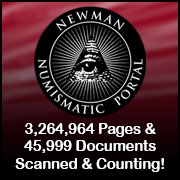
Visit our NBS Sponsors


About UsThe Numismatic Bibliomania Society is a non-profit association devoted to the study and enjoyment of numismatic literature. For more information please see our web site at coinbooks.org SubscriptionsThose wishing to become new E-Sylum subscribers (or wishing to Unsubscribe) can go to the following web page link MembershipThere is a membership application available on the web site Membership Application To join, print the application and return it with your check to the address printed on the application. Print/Digital membership is $40 to addresses in the U.S., and $60 elsewhere. A digital-only membership is available for $25. For those without web access, write to: Charles Heck, Treasurer AsylumFor Asylum mailing address changes and other membership questions, contact Chuck at this email address: treasurer@coinbooks.org SubmissionsTo submit items for publication in The E-Sylum, write to the Editor at this address: whomren@gmail.com BUY THE BOOK BEFORE THE COINSale Calendar |
- WAYNE'S WORDS: THE E-SYLUM APRIL 11, 2021
- 2021 NBS BOOK SALE CALL FOR DONATIONS
- NEW BOOK: SMALL GERMAN COIN CATALOG
- NEW BOOK: METAL FINDS AND COINS
- BANKNOTE BOOK SIAM, SAINT PIERRE CHAPTERS
- BOOK REVIEW: THE HALF CENT HANDBOOK
- A MYSTERIOUS WHITEHEAD & HOAG TOKEN
- JERSEYANA AND THE NOR*EASTER
- VIDEO: FEBRUARY 2021 COLLECTORAMA COIN SHOW
- MORE ON THE 1792 EAGLE-ON-GLOBE PATTERN
- WHAT CONSTITUTES A DIE VARIETY?
- THE FONROBERT PEACE OF BREDA MEDAL
- SELEUCID TETRADRACHM ISSUED BY DEMETRIUS II
- NOTES FROM E-SYLUM READERS: APRIL 11, 2021
- MORE ON J.N.T. LEVICK
- VOCABULARY TERM: DESIGN COMPETITION
- ISAIAH QUIMBY LUKENS (1779-1846)
- HARVEY STACK'S NUMISMATIC FAMILY, PART 93
- NATANYA VAN NIEKERK ACHIEVEMENT AWARD
- THE NUMISMATIC MUSEUM OF ATHENS
- ALBUM APRIL 2021 E-AUCTION 9
- NUMISMATIC NUGGETS: APRIL 11, 2021
- THE COINAGE OF ANCIENT MAURETANIA
- GLACIER ICE SAMPLES TRACK SILVER COIN USE
- MEDIEVAL HOARDS FOUND IN WALES
- THE 1866 NO MOTTO SEATED LIBERTY DOLLAR
- CORNING MAKES GLASS COVID-19 COINS
- THE HISTORY OF INDIA'S PAPER MONEY
- BANKNOTE EMBROIDERY AS POLITICAL ART
- LOOSE CHANGE: APRIL 11, 2021
Click here to read the thin version on the web
Click here to subscribe
Click here to access the complete archive
To comment or submit articles, reply to whomren@gmail.com
Content presented in The E-Sylum is not necessarily researched or independently fact-checked, and views expressed do not necessarily represent those of the Numismatic Bibliomania Society.
WAYNE'S WORDS: THE E-SYLUM APRIL 11, 2021
 New subscribers this week include:
Gregory Hale, courtesy Andrew Crellin;
Frank Sawin, courtesy Tom Caldwell;
Malcolm Webber, courtesy Shanna Schmidt;
Mike Nourse, and
James Rosen.
Welcome aboard! We now have 6,643 subscribers.
New subscribers this week include:
Gregory Hale, courtesy Andrew Crellin;
Frank Sawin, courtesy Tom Caldwell;
Malcolm Webber, courtesy Shanna Schmidt;
Mike Nourse, and
James Rosen.
Welcome aboard! We now have 6,643 subscribers.
Thank you for reading The E-Sylum. If you enjoy it, please send me the email addresses of friends you think may enjoy it as well and I'll send them a subscription. Contact me at whomren@gmail.com anytime regarding your subscription, or questions, comments or suggestions about our content.
This week we open with the NBS book sale, four new books, a review, updates from the Newman Numismatic Portal, and lots of reader comments.
Other topics this week include the 1792 Eagle-on-Globe pattern, die varieties, the Peace of Breda medal, collectors J.N.T. Levick and Robert Coulton Davis, the Numismatic Museum of Athens, the Stephen Album E-Auction, ancient and medieval coinage, the 1866 No Motto dollar, India's paper money, and banknote embroidery art.
To learn more about German coins, the paper money of Saint Pierre and Miquelon, surging numismatic book sales, Tulipmania, the Amon G. Carter, Jr. collection, coin designer Natanya Van Niekerk, Lyndon B. Johnson Hell Banknotes, ancient Mauretania, a glass challenge coin, and counterfeit elephant tokens, read on. Have a great week, everyone!
Wayne Homren
Editor, The E-Sylum
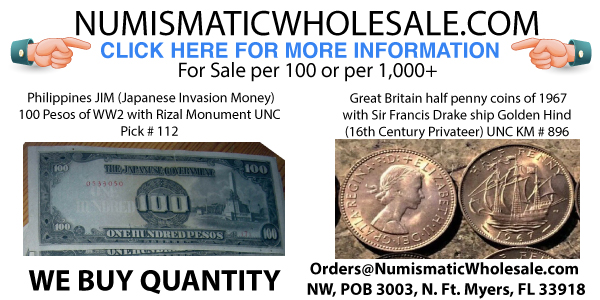
2021 NBS BOOK SALE CALL FOR DONATIONS
Numismatic Bibliomania Society Vice President Len Augsburger submitted this announcement regarding our annual fundraising book auction. Can you help with a donation? -Editor
Numismatic Bibliomania Society Charitable Auction
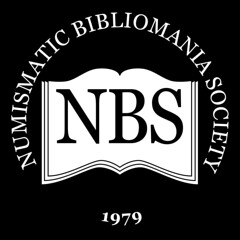 David Fanning has again graciously agreed to coordinate the NBS annual charitable auction. This event will be held at the NBS general meeting at the ANA August convention, or via mail bid if the ANA convention is cancelled. Book donations may be sent to Kolbe & Fanning, 141 W. Johnstown Rd., Gahanna, OH 43230. As the number of lots in the sale is limited, items valued at $100 and up are preferred. Please contact David Fanning prior to sending any shipments, at
df@numislit.com. In order to allow sufficient lead time, please contact David Fanning by June 30.
David Fanning has again graciously agreed to coordinate the NBS annual charitable auction. This event will be held at the NBS general meeting at the ANA August convention, or via mail bid if the ANA convention is cancelled. Book donations may be sent to Kolbe & Fanning, 141 W. Johnstown Rd., Gahanna, OH 43230. As the number of lots in the sale is limited, items valued at $100 and up are preferred. Please contact David Fanning prior to sending any shipments, at
df@numislit.com. In order to allow sufficient lead time, please contact David Fanning by June 30.
Last year's highest value lot was the Virgil Brand copy of the Wilson sale, cataloged by Thomas Elder, with recent binding by Scott Kellar, which realized $850. All proceeds from the charitable auction benefit the NBS and form an important part of our annual revenue. Following the sale, donors will receive receipts noting the estimated value as written in the catalog, and winning bidders will receive receipts totaling their winning bids.
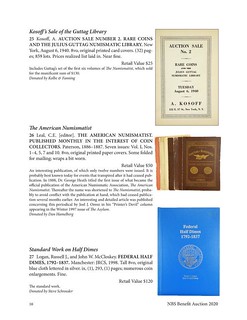
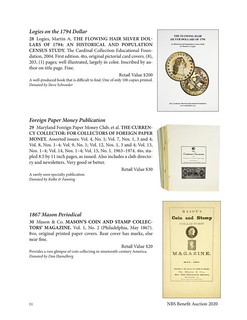
Link to previous NBS book sale catalogs:
https://nnp.wustl.edu/library/auctioncompanydetail/512295

NEW BOOK: SMALL GERMAN COIN CATALOG
I don't think we've discussed this one before. Here's a Google-translated description of a new edition from the publisher's website. -Editor
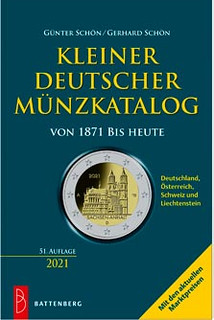 Small German coin catalog from 1871 until today
Small German coin catalog from 1871 until today
Dr. Gerhard Schön | Günter Schön
ISBN: 978-3-86646-200-7
Edition: 51st edition 2021
Images: illustrated in black and white
Softcover: 848 pages
Format: 12.5 x 19 cm For five decades the "Small German Coin Catalog" has been the most popular source of information for collectors of German coins. He is valued above all for the overview of circulation coins, commemorative coins, coin sets, numis sheets and numis letters. All over 3000 coin types are shown in their original size with front and back, all published and announced coin issues are recorded. The actual minting numbers, the current market prices for up to four degrees of preservation (fine, very fine, extremely fine, freshly minted) as well as the production methods stamped gloss and mirror gloss / polished plate are given.
For more information, or to order, see:
Kleiner deutscher Münzkatalog
(https://www.battenberg-gietl.de/sammeln/buch/kleiner-deutscher-muenzkatalog)
NEW BOOK: METAL FINDS AND COINS
Ted Banning passed along this notice of a new book that might be of interest to readers. Thanks. -Editor
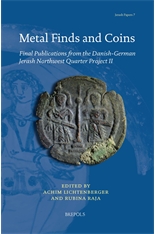 Metal Finds and Coins
Metal Finds and Coins
Final Publications from the Danish-German Jerash Northwest Quarter Project II
A. Lichtenberger, R. Raja (eds.)
XII+182 p., 47 b/w ill. + 19 colour ill., 9 b/w tables, 216 x 280 mm, 2020
ISBN: 978-2-503-58887-2
Languages: English
Paperback
Retail price: EUR 80,00 excl. tax
Website price: EUR 64,00 excl. tax (valid until 26/04/2021)
The final publications of the Danish-German Jerash Northwest Quarter Project is the most comprehensive publication on the archaeology of Gerasa, a Decapolis in northern Jordan, , since the 1938 publication edited by C. H. Kraeling.
The Decapolis city of Jerash has long attracted attention from both travellers and scholars, due both to the longevity of the site, and the remarkable finds uncovered during successive phases of excavation that have taken place from 1902 onwards. Between 2011 and 2016, a Danish-German team, led by the universities of Aarhus and Münster, focused their attention on the Northwest Quarter of Jerash — the highest point within the walled city — and this volume is the second in a series of books presenting the team's final results.
This volume offers an in-depth analysis of the coins and metal remains found in Jerash during the excavations. The contributions gathered here cover the small metal finds from the Northwest Quarter, as well as examining Greek, Roman, Byzantine, and Islamic coins.
Achim Lichtenberger and Rubina Raja are professors of classical archaeology and directors of the Danish-German Jerash Northwest Quarter Project. They specialise in the archaeology of the Mediterranean and Levant and have published widely on Gerasa and the region in general.
For more information, or to order, see:
Metal Finds and Coins
(http://www.brepols.net/Pages/ShowProduct.aspx?prod_id=IS-9782503588872-1)
Metal Finds and Coins: Final Publications from the Danish-German Jerash Northwest Quarter Project II
(https://www.brepolsonline.net/action/showBook?doi=10.1484%2FM.JP-EB.5.120491&)

BANKNOTE BOOK SIAM, SAINT PIERRE CHAPTERS
Owen Linzmayer publishes The Banknote Book, a useful, constantly updated electronic reference. The chapters on the banknotes of Siam (Thailand) and Saint Pierre and Miquelon are now available for $9.99 each. Saint Pierre and Miquelon is a French archipelago south of the Canadian island of Newfoundland. Here's the announcement. -Editor
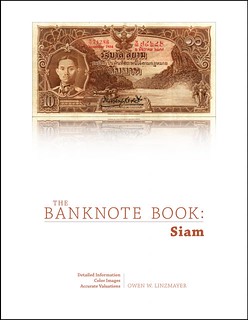
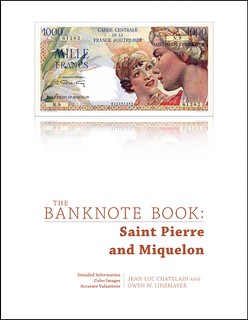
This week it is our pleasure to publish two significant new chapters. The Siam chapter completes coverage of the country that is now known as Thailand. The Saint Pierre and Miquelon chapter documents incredibly rare notes issued more than a century ago in a tiny outpost of the French empire. This is the first chapter co-authored by Jean-Luc Chatelain, who has been instrumental in compiling prefix/series range information throughout The Banknote Book. Enjoy!
Siam (East and Southeast Asia)
This 36-page catalog covers notes issued by the Royal Siamese Treasury from 1853 to 1892, the Government of Siam from 1902 to 1939, the Hong Kong and Shanghai Banking Company from 1889 to 1899, the Banque de l'Indo-Chine (Bank of Indo-China) from 1898 to 1904, and the Chartered Bank of India, Australia and China in 1898.
Saint Pierre and Miquelon (North America)
This 16-page catalog covers notes issued by the Banque des Isles Saint-Pierre et Miquelon (Bank of Saint Pierre and Miquelon Islands) from 1890 to 1897, the Chambre de Commerce (Chamber of Commerce) in 1920, G. Landry et Cie (Georges Landry and Company) in 1941, the Caisse Centrale de la France Libre (Central Bank of Free France) in 1941, and the Caisse Centrale de la France d'Outre-Mer (Central Bank of Overseas France) from 1944 to 1964.
Currently 298 chapters of The Banknote Book have been published as individual high-resolution PDF files. This represents a total of 7,384 pages covering 70,828 types and varieties.
For more information, or to order, see:
Siam
Saint Pierre and Miquelon
THE BOOK BAZARRE
BOOK REVIEW: THE HALF CENT HANDBOOK
Here's an excerpt of a recent CoinWeek review of Ed Fuhrman's new book on Half Cent varieties. -Editor
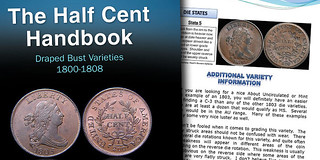 Since its release in 2019, The Half Cent: 1793-1857, self-published by former Early American Coppers (EAC) president William Eckberg, has been a mainstay at the CoinWeek offices for the information it provides on America's "greatest little coin". An update on Breen's outdated work, Eckberg's book is an accessible read – although it is written from Eckberg's particular perspective.
Since its release in 2019, The Half Cent: 1793-1857, self-published by former Early American Coppers (EAC) president William Eckberg, has been a mainstay at the CoinWeek offices for the information it provides on America's "greatest little coin". An update on Breen's outdated work, Eckberg's book is an accessible read – although it is written from Eckberg's particular perspective.
The direction that fellow EAC member Ed Fuhrman advances in his new book, The Half Cent Handbook: Draped Bust Varieties: 1800-1808, is certainly different. While the Fuhrman text is also written in a conversational tone, it focuses on collecting each issue by die variety and die state. That said, there is next to nothing provided here regarding the who, what, when, and why of each variety's creation. Fuhrman preempts this criticism by devoting a single page to lay out what is not covered in his book. Potential buyers should note that Fuhrman's uncovered areas include mintage figures, die variety emission sequences, historical background information, anecdotes about famous collectors, discussion of mint errors, and reverse die rotations for each variety. To us at the CoinWeek offices, these are critical areas of interest, and asking why can a volume cannot also include this information is fair and reasonable, given the title's $105 price.
On the other hand, Fuhrman readily admits that he is charting his own course with the way he chose to lay out his book. This is the author's right, but a clearer (and less defensive-sounding) explanation as to why certain areas of key information were omitted would have made these omissions less jarring.
That said, what the book clearly aims to accomplish is to mainstream the highly technical facets of the "on the coin" numismatics of half-cent variety attribution and die state collecting.
To read the complete article, see:
New Half Cent Handbook Looks to Demystify Collecting Half Cents by Variety and Die State
(https://coinweek.com/coins/supplies/books-2/new-half-cent-handbook-looks-to-demystify-collecting-half-cents-by-variety-and-die-state/)
To read earlier E-Sylum articles, see:
NEW BOOK: THE HALF CENT, 1793-1857
(https://www.coinbooks.org/v22/esylum_v22n20a02.html)
NEW BOOK: THE HALF CENT HANDBOOK
(https://www.coinbooks.org/v24/esylum_v24n08a06.html)
REVIEW: THE HALF CENT HANDBOOK
(https://www.coinbooks.org/v24/esylum_v24n09a07.html)

A MYSTERIOUS WHITEHEAD & HOAG TOKEN
The Newman Numismatic Portal attracts visitors from all over the U.S. and the world. Often their questions are easily answered, but sometimes a mystery lingers. Project Coordinator Len Augsburger has a question to pass on to E-Sylum readers. -Editor
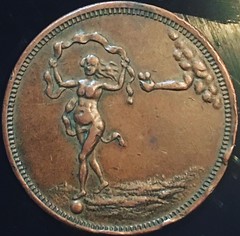
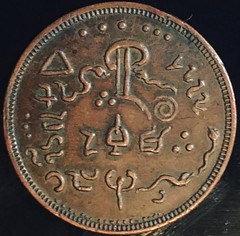
A Mysterious Whitehead & Hoag Token
A Newman Portal user asked about this Whitehead & Hoag Token, which was found in a collection left by her grandfather, a World War II veteran. Whitehead & Hoag were American manufacturers active in the early 20th century, but their records were all later destroyed. Roy Harte reported this piece in Coin World, February 10, 1965, and there suggested the obverse depicted Eve's temptation in the Garden of Eden. The reverse was recently shared with a number of Hebrew scholars, who could identify neither paleo or modern Hebrew characters. Google translate offered inconsistent results when attempting to decipher the reverse characters. Can any E-Sylum readers help?

Images: Whitehead & Hoag token, with closeup of manufacturer's name
Interesting. This has the look of a rebus puzzle, but I'm just as stumped as everyone else. None of this makes any sense to me. But an answer is out there somewhere. Thoughts, anyone? You can click thru on the images to higher-resolution versions on our Flickr archive. -Editor
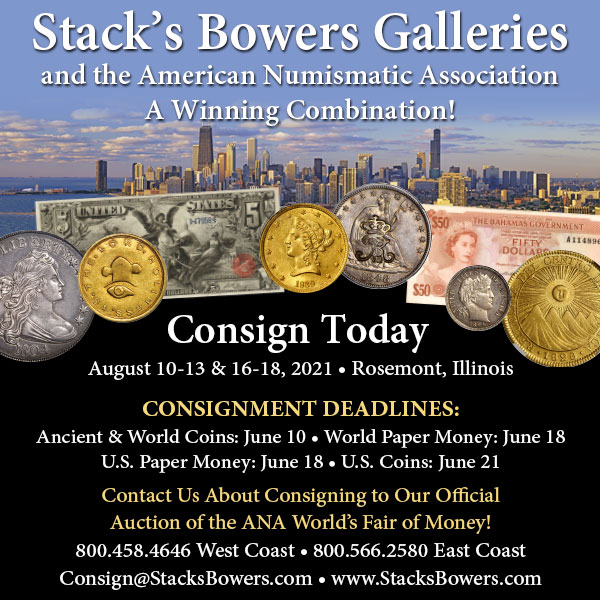
JERSEYANA AND THE NOR*EASTER
David Gladfelter passed along this note about the history of the New Jersey Exonumia Society (1980 to 2010) and its publications Jerseyana and the short-lived The Nor*Easter (now archived on the Newman Portal). Thanks. -Editor
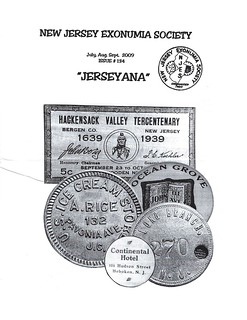
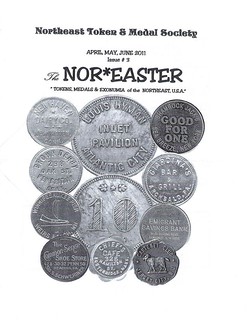
David writes:
"In 2010, in a bid to grow its membership, NJES broadened the newsletter's scope to cover exonumia of the northeastern states, and changed its own name to Northeast Token and Medal Society. "Jerseyana" then became "The Nor*Easter" and published five issues. The change actually brought in quite a few new members but the progress was short lived -- our hard working editor for many years developed serious health problems and couldn't continue.
"The final issue is internet-only and includes a story about the windup."
Here's an excerpt from the issue. -Editor
On May 19, 2012. the Northeast Token and Medal Society (formerly the New Jersey Exonumia Society) held its last meeting, six months after publication and distribution of the last regular issue of its quarterly newsletter, The Nor*Easter.
The difficult decision was made to disband. After payment of outstanding bills and refund of dues paid, [Treasurer] Bob [Schopp] sought advice on what to do with the remaining balance... The members decided to donate the funds to the Token and Medal Society (TAMS).
The entire 32-year combined run of Jerseyana and The Nor*Easter has now been placed on the Newman Numismatic Portal, courtesy of Leonard Augsburger, its project coordinator. This seems an appropriate time, therefore, to "publish" the long-delayed farewell issue, although in internet form rather than on the old-fashioned paper preferred by many readers. Members will be notified that if they provide an email address, this issue will be sent to them on line. Of course, it can be printed out and kept with a paper set.
And TAMS will shortly receive a donation of $156.47 as NETAMS wound up in the black.
To read the publication on the Newman Numismatic Portal, see:
JERSEYana
(https://nnp.wustl.edu/library/publisherdetail/514335)
VIDEO: FEBRUARY 2021 COLLECTORAMA COIN SHOW
These are selections from the David Lisot Video Library that feature news and personalities from the world of coin collecting. David has been attending coin conventions since 1972 and began videotaping in 1985. The Newman Numismatic Portal now lists all David's videos on their website at:
https://nnp.wustl.edu/library/multimediadetail/522852
Here's one on the February 2021 Collectorama Coin Show. -Editor
Collectorama Coin Show Offers Collector Haven During COVID February 18, 2021.
VIDEO: 10:51
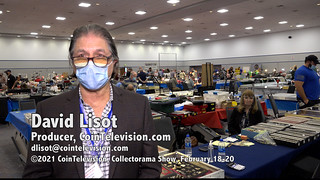 February 18, 2021. David Lisot, Interviewer, CoinTelevision.com, with Rick & Patricia DeSanctis, Larry Garvin, John Bremer, Greg Allen, Robert Calderman, and Audra, Thatcher, & Cutler Emberton.
February 18, 2021. David Lisot, Interviewer, CoinTelevision.com, with Rick & Patricia DeSanctis, Larry Garvin, John Bremer, Greg Allen, Robert Calderman, and Audra, Thatcher, & Cutler Emberton.
People are anxious to get out and go somewhere during the COVID Crisis Pandemic of 2021. What better place to go than to a coin show! But is it safe? David Lisot speaks to participants at the Collectorama Coin & Currency Convention in Lakeland, Florida to find out why people come the show and whether they feel safe. He also speaks to them what is popular for coins and banknotes at the gathering.
An excerpt of the video is available for viewing on the Coin Television YouTube Channel at:
https://youtu.be/OsSOfSmk9eo

MORE ON THE 1792 EAGLE-ON-GLOBE PATTERN
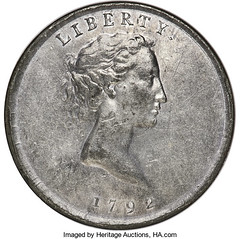
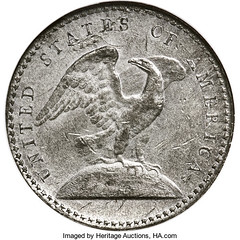
Bill Eckberg writes:
"The Heritage lot description, relying on traditional speculation from the 1960s, reads like an advertisement, which it is, for a spectacularly important coin, which it may or may not be.
"Pete Smith's revisionist comments are spot on.
"Readers might also be reminded that Crosby referred to it as a cent, not a quarter and that, though a piece in copper came into the Mint collection from Adam Eckfeldt, nothing is known of its origin. Even Eckfeldt didn't claim to know anything about it.
"It is also worth noting that on his deathbed, Wright requested to be paid for the Henry Lee Comitia Americana medal dies he engraved and for the dies for a quarter dollar pattern that broke in hardening. His estate was paid only for the dies for the medal. The Eagle-on-Globe dies obviously struck a few pieces and so apparently did not break in hardening, suggesting that it was not the quarter dollar pattern.
"It's a lovely piece, but there's no evidence it was engraved by Wright, that it was a 1792 pattern, or, if it WAS a pattern from the early Mint, what it was a pattern for.
"Like the suppositions about the "Continental Dollar," the suppositions about this piece are all inventions from numismatists writing over a century and a half after the date on the coin.
"We need, at some point, to require evidence for spectacular claims like the ones about this piece."
Alan V Weinberg writes:
"Regarding the "2002 discovery" of the two 1792 Judd 13 white metal Wright quarters: Actually, I saw both pieces on display in a vertical glass display case with other early American pieces (including a gold Erie Canal medal) in 1999 while visiting the New-York Historical Society, and at that time inquired of NYHS curator Ms. Hofer of their origin, learning only they'd been in the Society collection back to 1808, its founding.
"I almost immediately decided to work a trade of my unique hand-engraved large gold 1854 New York lifesaving medal for one of the two Judd 13s and was told this trade would have to be approved by the NY state legislature.
"I made the mistake of mentioning the proposed trade to a prominent NYC dealer who advised the Society against such a trade."
"So the pieces were "discovered" in 1999, not 2002."
Thanks, everyone. Great discussion and background. -Editor
To read the earlier E-Sylum article, see:
1792 EAGLE-ON-GLOBE QUARTER PATTERN
(https://www.coinbooks.org/v24/esylum_v24n14a19.html)

WHAT CONSTITUTES A DIE VARIETY?
Last week Bill Eckberg asked:
"What Constitutes a Die Variety?
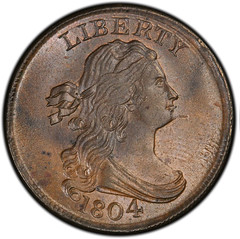 "I have talked to guys who say a die is a piece of metal, and if somebody recuts something or changes something it's the same die. Others think that even the tiniest change, like the strength of a berry stem makes for a new variety."
"I have talked to guys who say a die is a piece of metal, and if somebody recuts something or changes something it's the same die. Others think that even the tiniest change, like the strength of a berry stem makes for a new variety."
"Personally, I think any alteration has to be significant and not accidental. In the half cent world, the 1795 no-pole obverse is just a reground with-pole obverse that was used earlier. Similarly, the Spiked Chin obverse was apparently the result of some kind of damage. I consider both of those to be die states after their alteration, whether intentional or accidental."
Brad Karoleff writes:
"My definition of a die "variety" will be different than a die "marriage", which is what I think Bill is talking about here."
"A die MARRIAGE is a coin struck from two specific dies IE: Obverse 1 and Reverse A. ANY alteration to either of these two dies when striking a coin from the same two individual dies is a die STATE or STAGE as some are using. If these two dies are taken out of service and used with other dies to make new marriages and in that usage change in characteristics (die clashes, cracks, wear or lapping) and are REUSED in their new states with each other you now have a die REMARRIAGE."
"A die VARIETY is somewhat less specific. I define it as a significant deviation from normal. Let's assume in the last instance that obverse die 1 is an overdate. All coins struck using that obverse die no matter the reverse is the overdate VARIETY that can be represented by numerous die MARRIAGES. Now let's assume a reverse die has a blundered denomination. It can be paired with numerous obverse dies to create numerous die MARRIAGES but all are the blundered die VARIETIES."
"How about that for muddying the numismatic waters?"
Dave Lange writes:
"Regarding the definition of a "variety," I prepared several years ago a brief tutorial program addressing this very subject which is now posted at NGC's VarietyPlus website."
Thanks, everyone. Here's an excerpt from Dave's explanation. See the complete article online for more. -Editor
A variety is a coin that has characteristics specific to the die pair that struck it. Most collectible varieties can thus be traced to a set of dies.
There seems to be some confusion as to exactly what constitutes a variety. In United States numismatics, a variety may be defined as a die or die pairing that offers some distinctive feature not a normal part of the design. For early U. S. coins, those made before the introduction of the reducing lathe in 1836, every die required extensive hand punching of letters, numerals and other small features. Therefore, each and every die was distinctive, and each die pairing constitutes a variety. Thus, all coins from this period are of some identifiable variety, and each die pairing may be identified by number under NGC's VarietyPlus service.
In the case of modern coins, most features of the design were included in a master hub, from which a series of transfers were made to produce working dies. Very little hand punching was done, aside from the addition of the date and mintmark. Since early in the last century, the date has been an integral part of the master die for each year and has not varied within that year. The same has been true of mintmarks since 1990, and today's coin dies are typically indistinguishable. Though numerous doubled dies, overdates, repunched mintmarks and the like have occurred over the past century, these were the exceptions rather than the rule. Nevertheless, they do qualify as varieties and may be attributed as such under NGC's VarietyPlus service.
NGC utilizes numerous other designations that do not, however, constitute varieties. These include designations such as FH for Full Head, FT for Full Torch and FBL for Full Bell Lines. Likewise, the designations BN, RB and RD for Brown, Red-Brown and Red, respectively, are not varieties.
NGC does not attribute as varieties coins that display Strike Doubling, Abrasion Doubling, Die Deterioration Doubling, Master Die Doubling (doubling that is found on all coins made produced from that master die), insignificant die chips, breaks, cracks or any variety coin that falls under mint tolerances for doubling or normal die wear.
With few exceptions, NGC will not attribute die varieties that require greater than 5x magnification to be clearly recognizable.
To read the complete article, see:
What is a Variety?
(https://www.ngccoin.com/variety-plus/what-is-a-variety/)
Bill Eckberg adds:
"Reading these replies, I realize that I didn't phrase my question very well. What I was trying to get at was, how much difference is required between two coins before we say they were struck from different dies?"
Not everyone may agree with NGC's one-size-fits-all definition of requiring greater than 5x magnification to be clearly recognizable, but it's a practical benchmark. -Editor
To read the earlier E-Sylum article, see:
NOTES FROM E-SYLUM READERS: APRIL 4, 2021 : What Constitutes a Die Variety?
(https://www.coinbooks.org/v24/esylum_v24n14a07.html)

THE FONROBERT PEACE OF BREDA MEDAL
Last week Dave Hirt asked about Lot #2920 on the 1878 Jules Fonrobert sale of coins, tokens, and medals of North America. A silver piece listed under New York City is described as follows (in German). Thanks to Ron Haller-Williams for the image. -Editor
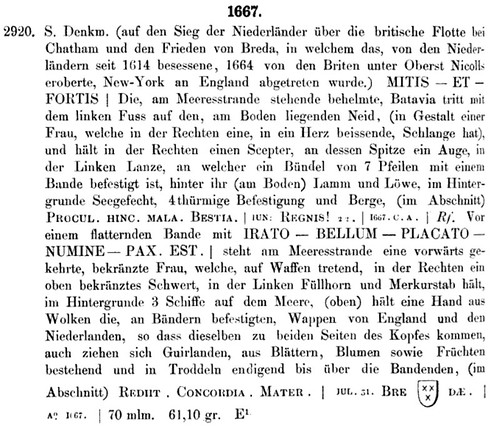
Dave Lange writes:
"In response to David Hirt's inquiry, I summoned up my mostly forgotten high school German. I believe the legends describe the siege of New Netherland (English spelling), the Dutch colony in what is now New York State. The colony surrendered to its British invaders around this same time. The name of the colony then became New York, and its primary settlement at the foot of Manhattan, New Amsterdam, was renamed New York City. It is from this history that New Netherlands (the "s" was in error) Coin Company was established in 1936."
Ron Haller-Williams writes:
"No wonder Dave Hirt was unable to find this piece in Krause! It is a silver commemorative medal ("S[ilber] Denkm[al]"), NOT a coin. By the way, it is rather large for a coin - 70mm in diameter, and this specimen weighed 61.10 grams. And its connection with New York is somewhat tenuous ..."
The medal was struck "auf den Sieg der Niederländer über die britische Flotte bei Chatham und den Frieden von Breda, in welchen das, von den Niederländern seit 1614 besessene, 1664 von den Briten unter Oberst Nicolls eroberte New York an England abgetreten wurde" ("on the victory of the Dutch over the British fleet at Chatham and the Peace of Breda, in which New York, which had been possessed by the Dutch since 1614 and conquered by the British under Colonel Nicolls in 1664, was ceded to England").
"The only connection to New York is that, among other things, this treaty determined the fate of New York."
"My understanding is that this refers not specifically to the "city that never sleeps" but to the entire territory/colony - which, of course, became the State of New York somewhat over a century later - and about a century before the Fonrobert sale.
"Medallic Illustrations" lists two medals for the Medway matter (#174 & #175), and 12 commemorating the Peace/Treaty of Breda (#176 thru #187). For this one, it gives quite a lot of interesting background."
Martin Purdy writes:
"(auf den Sieg der Niederlander aber die britische Flotte bei Chatham and den Frieden von Breda...)"
"I assume "aber" (but) in the first few words is a mistranscription and should be "über" (over): "On the victory of the Dutch over the British fleet off Chatham and the Peace of Breda, in which New York, occupied by the Dutch since 1614 and captured by the British under Colonel [variously Colonel/Admiral/Governor according to my web search] Nicolls in 1664, was ceded to England."
Axel Kornfuehrer agrees. He writes:
"While I don't have the Fonrobert catalog he mentions, I can read German: "[This silver coin commemorates] the victory of the Netherlanders over the British fleet at Chatham and the peace of Breda, in which New York, owned since 1614 by the Netherlanders, 1664 conquerted by the British under Colonel Nicolls, was ceded to England."
"I wonder if the word "aber" [but] in Dave Hirt's note should not be "über/ueber" [over]."
Makes sense. Ron also provided the below links and this excerpt from Medallic Illustrations . -Editor
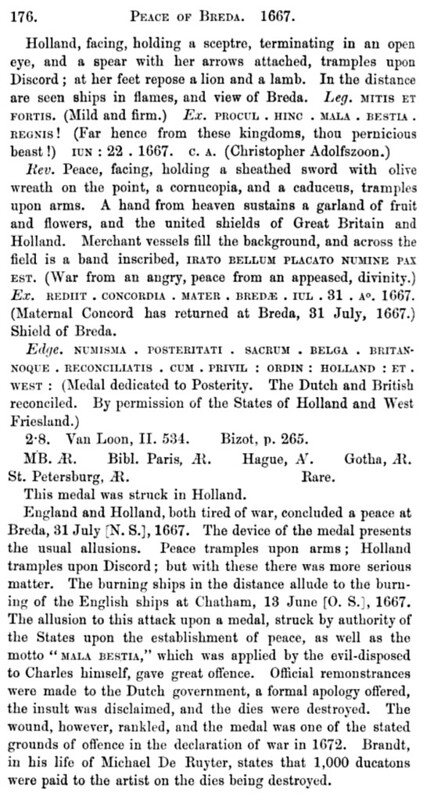
To read the Fonrobert catalog, see:
Jules Fonrobert's collection of overseas coins and medals: I. Abbot. North America
(https://www.google.com/books/edition/_/PDQGAAAAQAAJ?gbpv=1)
To read about the Treaty of Breda, see:
Treaty of Breda (1667)
(https://en.wikipedia.org/wiki/Treaty_of_Breda_(1667))
Ron adds:
"Here is a scan of the illustration of the piece, from Plate LII of my copy of Medallic Illustrations ."
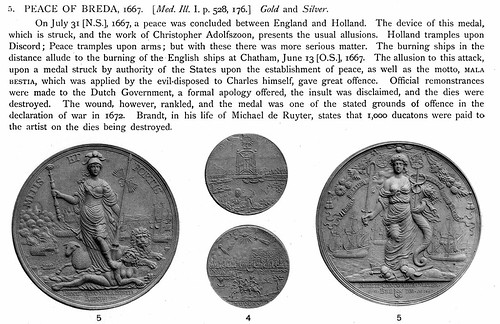
So now we know what that Fonrobert entry was all about. Great medal. Important history. Thanks, everyone! -Editor
To read the earlier E-Sylum article, see:
NOTES FROM E-SYLUM READERS: APRIL 4, 2021 : Query: Fonrobert Sale 1667 New York Coin
(https://www.coinbooks.org/v24/esylum_v24n14a07.html)

SELEUCID TETRADRACHM ISSUED BY DEMETRIUS II
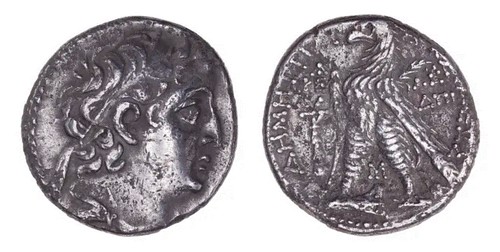
Russell Atherton writes:
"Interesting and significant fact about the coin featured in "Second Temple Period Shekel Rediscovered": It isn't a Tyrian shekel. It is a Seleucid tetradrachm issued by Demetrius II. It looks quite similar to the civic issues with the Melqart obverse, but the obverse is a portrait of Demetrius II. In fact, his name is clearly included on the reverse -- which of course never appears on the coins known as Tyrian shekels.
Thanks for your faithful work in compiling this excellent weekly resource!"
Bob Leonard writes:
"The piece is illustrated, and on it we can read the name Demetri..., for the Seleucid king Demetrius II Nicator, 145-139, 129-125 BC, circa 129/28 BC (not sure if I am reading the date correctly, but this should be close). It is a tetradrachm, not a "shekel," though Tyrian shekels are really tetradrachms too, but were of sufficient weight to pay the half shekel Temple tax for two men. When Tyre became independent in 125 BC, it continued the design of the Seleucid tetradrachm, merely substituting the image of the god Melkart, patron deity of Tyre, for the Seleucid king, changing the reverse inscription, and adding a date based on the era of its independence.
"The rarity of this coin is also much overrated. Some years ago I did a study of hoards of shekels of Tyre just from Israel (excluding Lebanon, where Tyre is actually located), and came up with 6,000 pieces or so in total; I have two varieties in my collection. For the actual tetradrachm of Demetrius II, the American Numismatic Society holds 38 examples."
Thanks, everyone. -Editor
To read the earlier E-Sylum article, see:
SECOND TEMPLE PERIOD SHEKEL REDISCOVERED
(https://www.coinbooks.org/v24/esylum_v24n14a16.html)

NOTES FROM E-SYLUM READERS: APRIL 11, 2021
More on Those Love Tokens on Counterfeit Quarters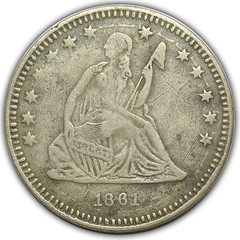
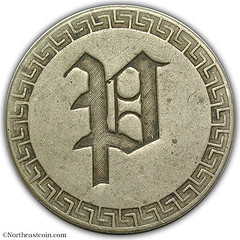
Regarding Jeremy Bostwick's article on the Love Token on counterfeit 1861 Seated Liberty Quarters, Tom Caldwell of Northeast Numismatics writes:
Of the examples presented ours seems to be the only one that was not used as jewelry. Guessing other letters of the alphabet will show up. The explanation of it being a cottage industry makes a lot of sense."
Thanks for passing along the original item. Interesting story! -Editor
To read the earlier E-Sylum articles, see:
NOTES FROM E-SYLUM READERS: MARCH 28, 2021 : Love Token on Counterfeit Seated Quarter
(https://www.coinbooks.org/v24/esylum_v24n13a11.html)
LOVE TOKENS ON COUNTERFEIT SEATED QUARTERS
(https://www.coinbooks.org/v24/esylum_v24n14a08.html)
Dennis Tucker of Whitman Publishing writes:
"There's a surge in numismatic book sales of late. We've already sold out the first print run of the Continental Currency book, as well as the 2nd edition of the Guide Book of Gold Eagle Coins and the Check List and Record Book of United States and Canadian Coins. Americans seem to be getting back to the classic hobbies, much as we did during the Great Depression."
That's great news. I'm glad to hear the boost in hobby activity hasn't left book sales behind. It's a good sign of the continued numismatic renaissance that coincided with the pandemic.
Here are a couple notes from Dick Hanscom on the March 28th issue that I didn't manage to get in last time. -Editor
Dick writes:
"Back in the late 70s, early 80s, I purchased four souvenir ashtray dies: On the White Pass & Yukon Railway, harbor view of Skagway, White Horse Rapids and Alaskan Express (dog team). All designs were taken from post cards circa 1910-1920). I sent all of these dies Medallic Arts Co. to use in making 3 inch, uniface bronze medals. On the last one, Alaskan Express, I had a process set made (maybe 2 or 3). Sadly, when Medallic Arts went bankrupt (the first time), I lost the White Pass & Yukon die. I am in contact with the American Numismatic Society in hopes of recovering it."
Good luck with your quest! -Editor
To read the earlier E-Sylum article, see:
THE NEW YORK WORLD'S FAIR MEDAL PROCESS SET
(https://www.coinbooks.org/v24/esylum_v24n13a10.html)
Dick adds:
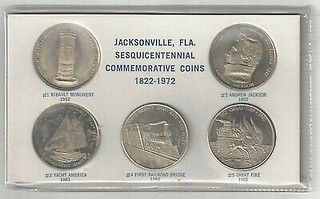 "As to Jan Monroe's question about who minted the medals shown, I would try Wendell's in Minneapolis. They seem to have made most of the Alaska Purchase Centennial medals in 1967 (FYI -next issue of my newsletter will have some 1967PC medals). They were active in 1967 and later in making medals for the Alaska market (they made medals for the Fairbanks Coin Club in 1965, 1972-74). They were so prolific in making medals for Alaska, they must have been making them for others."
"As to Jan Monroe's question about who minted the medals shown, I would try Wendell's in Minneapolis. They seem to have made most of the Alaska Purchase Centennial medals in 1967 (FYI -next issue of my newsletter will have some 1967PC medals). They were active in 1967 and later in making medals for the Alaska market (they made medals for the Fairbanks Coin Club in 1965, 1972-74). They were so prolific in making medals for Alaska, they must have been making them for others."
Thanks. Sounds like a good starting point. Dick's excellent newsletter is the Alaskan Token Collector and Polar Numismatist . Note that earlier researcher Sheldon Banoff had contacted the company and was told they hadn't retained records and couldn't help with research requests. -Editor
To read the earlier E-Sylum article, see:
QUERY: RECORDS OF MINNEAPOLIS MEDAL MAKER WENDELL'S SOUGHT
(https://www.coinbooks.org/esylum_v12n34a10.html)
NOTES FROM E-SYLUM READERS: MARCH 28, 2021 : Query: Medal Manufacturer Sought
(https://www.coinbooks.org/v24/esylum_v24n13a11.html)
Lianna Spurrier passed along an example of her editing magic in making the faked version of the Drowne letter shown in the NNP April Fools video about "new evidence" on the origins of the Continental Dollar. Thanks! -Editor
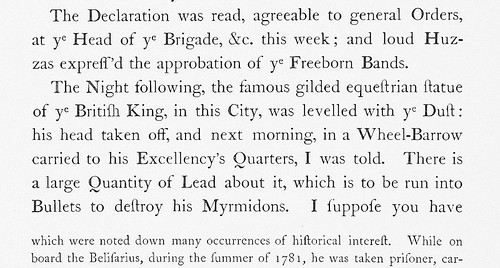
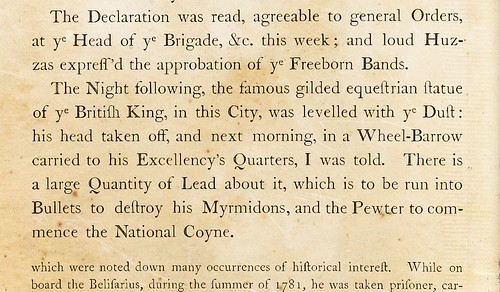
To read the earlier E-Sylum articles, see:
NEW CONTINENTAL DOLLAR EVIDENCE EMERGES
(https://www.coinbooks.org/v24/esylum_v24n13a07.html)
NO STATUE WAS HARMED TO MAKE CONTINENTALS
(https://www.coinbooks.org/v24/esylum_v24n14a06.html)
Regarding translations of the 1785 German sale of a Continental Dollar, Martin writes:
"Attempts to read the "f" in "fl" as a "long s" or "pr" as "geprägt" (struck) don't really work, unfortunately. The first can be ruled out by comparing matching letters in the same document, and a Google search will bring up examples of both "pr" and "per" in older texts containing amounts in florins.
"No matter which way I look at it, I can't get any further than "struck in tin (i.e. pewter in this case) per [at a rate of] 5 gulden" - but what that actually *means* is still uncertain. Most likely is that the pewter coins cost 5 fl. each to make, or that was their issue price. A much longer shot would be a reference to the grade of the pewter - "struck in pewter which costs 5 fl. for a standard unit weight", whatever that might have been - as opposed to any cheaper or more costly grade of metal, for example."
Martin also provided a longer and more detailed discussion, which I've forwarded to Julia Casey. Thank you! -Editor
To read the earlier E-Sylum articles, see:
CONTINENTAL DOLLAR OFFERED FOR SALE IN 1785
(https://www.coinbooks.org/v24/esylum_v24n12a10.html)
MORE ON THE 1785 CONTINENTAL DOLLAR SALE
(https://www.coinbooks.org/v24/esylum_v24n13a08.html)
Regarding last week's article on the 600-piece Roman denarii hoard found in Bulgaria, Arthur Shippee writes:
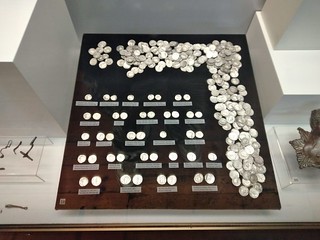 "A big hoard. A denarius is often glossed as a laborer's daily wage in 1st C., N.T. times, so this is a big deal for a small person. The age covered about 90 years; I wonder what condition the earlier coins were — really, I wonder if we can tell if this hoard were slowly built up over years (1 D/Mo over 5 years?). Or how it came together. It prompts tragic questions."
"A big hoard. A denarius is often glossed as a laborer's daily wage in 1st C., N.T. times, so this is a big deal for a small person. The age covered about 90 years; I wonder what condition the earlier coins were — really, I wonder if we can tell if this hoard were slowly built up over years (1 D/Mo over 5 years?). Or how it came together. It prompts tragic questions."
To read the earlier E-Sylum article, see:
ROMAN SILVER COIN HOARD FOUND IN BULGARIA
(https://www.coinbooks.org/v24/esylum_v24n14a17.html)
Gil Parsons writes:
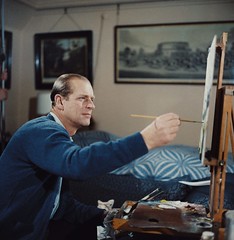 "A not widely-known aspect of Prince Philip Duke of Edinburgh, perhaps worth noting on the occasion of his passing. The following is an excerpt from an Artnet News article on the Prince's wide-ranging artistic pursuits and patronage (Philip was a painter, oversaw the repair of Windsor Castle after the fire, collected many contemporary artists, many of which artworks are now in the Royal Collection Trust, numbered artists among his friends):
"A not widely-known aspect of Prince Philip Duke of Edinburgh, perhaps worth noting on the occasion of his passing. The following is an excerpt from an Artnet News article on the Prince's wide-ranging artistic pursuits and patronage (Philip was a painter, oversaw the repair of Windsor Castle after the fire, collected many contemporary artists, many of which artworks are now in the Royal Collection Trust, numbered artists among his friends):
"At times, his interest in art and design was entwined with his official position. From 1952 to 1999, he was the president of the Royal Mint Advisory Committee, where he helped oversee the designs for coins, seals, and medals, and was instrumental in the launch of a newly designed coinage released in 1952, produced to mark the beginning of the queen's reign.""
Thank you - I wasn't aware of that numismatic connection. -Editor
To read the complete article, see:
The Late Prince Philip Was a Devoted Patron of the Arts and a Hobbyist Painter—Here Are Some of His Most Notable Pursuits
(https://news.artnet.com/art-world/prince-philip-as-a-patron-of-the-arts-and-an-hobbyist-painter-1958058)
David Pickup passed along this Royal Mint page for the 2017 Prince Philip coins, which also mentions his services on the Royal Mint Advisory Committee . Thanks. -Editor
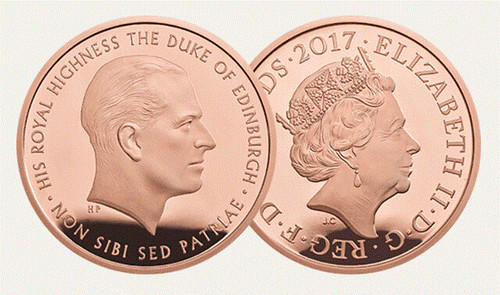
His Royal Highness The Prince Philip, Duke of Edinburgh retired from public engagements in the summer of 2017 at the age of 96. Beginning with service in the navy in 1939, through his steadfast support of Her Majesty The Queen as the longest serving consort and his leadership of hundreds of charities, Prince Philip's record of service and achievement is unlikely to be equalled. As he reflects on nearly 80 years of service, this is also a significant moment for The Royal Mint, as The Duke of Edinburgh served as President of The Royal Mint Advisory Committee from 1952 until 1999.
For more information, or to order, see:
Prince Philip Coins
(https://www.royalmint.com/our-coins/events/prince-philip/)
John Phipps writes:
"As a non-numismatic corollary to your comment,
"Considering that no one seems to be able to read an analog clock dial anymore, I'm not surprised. The same generational effect was likely present after the widespread adoption of mechanical clocks. "Kids these days, can't even read a simple sundial..."
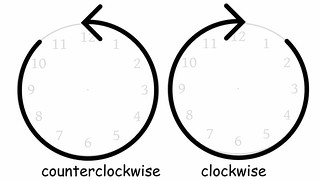 'As a purchasing manager at a small engine components company, I had just gotten out of a meeting with the engineering manager and a newly hired process engineer. In the meeting the new hire was asked to change a work cell from linear to counter clockwise. Later he came to my office and said he needed to ask a question, "Which way is counter clockwise?" A bachelors and masters with five years of experience in mechanical engineering and didn't know counter clockwise!!"
'As a purchasing manager at a small engine components company, I had just gotten out of a meeting with the engineering manager and a newly hired process engineer. In the meeting the new hire was asked to change a work cell from linear to counter clockwise. Later he came to my office and said he needed to ask a question, "Which way is counter clockwise?" A bachelors and masters with five years of experience in mechanical engineering and didn't know counter clockwise!!"
To read the earlier E-Sylum article, see:
NOTES FROM E-SYLUM READERS: APRIL 4, 2021 : The Change in Change-Making
(https://www.coinbooks.org/v24/esylum_v24n14a07.html)
Dave Lange writes:
"The name Harry Lelande rang a bell for me, and I intended to send the below image last week but got too busy to do so. It's taken from the back of a J. Oberwise & Company coin board from the early 1940s and lists a coin guide book for sale. Given the difference in spelling it may be that there's no relationship between Harry Lelande and James L. Lelonde; I wasn't able to find any connection on Ancestry.com. Even so, I thought it an interesting coincidence that they were both involved in numismatics."

Thanks. I'd never seen nor heard of Lalonde's Lincoln Cent catalog. Does anyone have one in their library? -Editor
To read the earlier E-Sylum article, see:
HARRY JASON LELANDE (1871-1965)
(https://www.coinbooks.org/v24/esylum_v24n13a14.html)
NOTES FROM E-SYLUM READERS: APRIL 4, 2021 : The Harry Lelande Auction Catalog
(https://www.coinbooks.org/v24/esylum_v24n14a07.html)
Levin Messick writes:
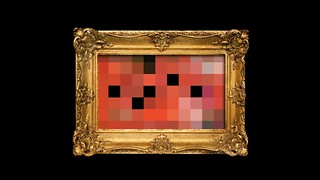 "I read the article by Anil Dash on NFTs with interest. It seems that both he and Kevin McCoy the other inventor are pointing out that the entire system is extremely shaky as it depends on a flawed bitchain model and on one company staying in business possibly forever? Good luck with that.
"I read the article by Anil Dash on NFTs with interest. It seems that both he and Kevin McCoy the other inventor are pointing out that the entire system is extremely shaky as it depends on a flawed bitchain model and on one company staying in business possibly forever? Good luck with that.
"As far as the current crazed prices are concerned I was reminded of that old saying "A fool and his money are soon parted". I would advise any of our readers who might be thinking about investing to read about Tulipmania in "Extraordinary Popular Delusions and the Madness of Crowds" which brings up another old saying- "There is nothing new under the sun".
"Finally, while I am bringing up historic sayings it occurs to me that we may have opened a new "Pandora's Box" and "we should be careful what we wish for because we just might get it and not like it when we do" I won't even go into the tax and counterfeiting issues that bitcoin raises for our Federales to ponder.
"PS- The "Dutch" still grow tulips but no one pays a million guilders for one now days!"
To read the earlier E-Sylum articles, see:
LOOSE CHANGE: NOVEMBER 1, 2020 : Tulipmania: More Boring Than You Thought
(https://www.coinbooks.org/v23/esylum_v23n44a29.html)
MORE ON NON-FUNGIBLE TOKENS
(https://www.coinbooks.org/v24/esylum_v24n14a13.html)
VIRTUAL MARKET ENJOYS ASTONISHING SUCCESS
(https://www.coinbooks.org/v24/esylum_v24n13a32.html)
Jonas Denenberg writes:
"I'm looking for a Santamaria, Rome auction catalog from 1939. None have been digitized but one sold at auction for 100 Pounds. Might you have one at any chance?"
I don't have the catalog - most of mine are sales of U.S. coins. Jonas is researching the provenance of a coin he recently purchased. Here's a summary of what he learned from the seller:
- Purchased/donated to British Museum from 1892-1913 (likely 1910) by Dr. Paul Hartwig
- Sold in Santamaria auction in 1939
- unknown ownership until purchased by Colby J. Abele at a California coin show
- Purchased by Jonas in March, 2021
Can anyone help? -Editor
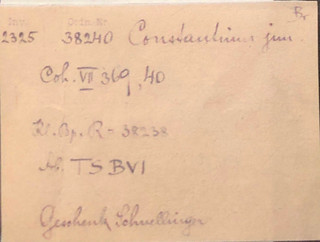
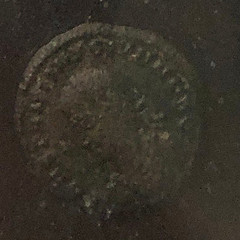
Ken Spindler writes:
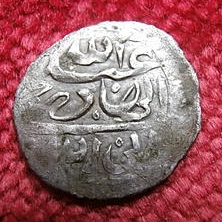 "I've been annoyed by the news articles repeated everywhere (now including The E-Sylum) indicating that the 17th century Islamic & Spanish coins found in the Northeast, very possibly a pirate's loot that the pirate couldn't find anyone to accept as money, were "ancient." I doubt that news article was written by a reporter who is well-versed in world history. I actually wrote to my local newspaper to complain about it when they repeated it, just a few days ago."
"I've been annoyed by the news articles repeated everywhere (now including The E-Sylum) indicating that the 17th century Islamic & Spanish coins found in the Northeast, very possibly a pirate's loot that the pirate couldn't find anyone to accept as money, were "ancient." I doubt that news article was written by a reporter who is well-versed in world history. I actually wrote to my local newspaper to complain about it when they repeated it, just a few days ago."
Reporters have a miserable job. They're measured by quantity of product, not quality. They publish something that looks OK and move on quickly to something else. I have the same pressure every week, but I welcome the chance to set the record straight. I didn't notice that part of the article. I certainly agree that coins from the 1700s are not ancient, but in the eyes of the general public, that's how they seem. Here's an excerpt of Ken's Letter to the Editor of his local paper. -Editor
The reference to 17th-century coins in the article title and article text ... as "ancient" is historically inaccurate. A coin would have to be over 1000 years older than any of the coins involved to be "ancient." Coins stolen from seafarers in 1695 or thereabouts were just contemporary circulating coins, not ancient ones! Why would commoners be holding ancient coins? The ancient world ended at the end of the eastern Roman Empire. After that period of world history, came the medieval period ("Middle Ages"). A 17th century coin is simply a 17th century coin. It's not even very old, by numismatic standards, except to novices. The Islamic and Spanish coins in the photo are most likely very common, and probably worth no more than a few dollars each, now.
And in the 1700s only the silver or gold content mattered, not whatever image or text was stamped on the coin. Silver coins, no matter how strange looking, would be accepted for their weight in silver. It's still an interesting story when coins surface so far from their point of origin, but the inclusion of the word "pirate" is likely what turned an otherwise normal article into the clickbait phenom that took the story viral last week.
The publicity netted Jim Bailey an interview yesterday with National Public Radio's Scott Simon, replete with Pirate jokes (and the "ancient" word, unfortunately). But it ended well, I thought. -Editor
SIMON: You are a metal detectorist.
BAILEY: That's correct.
SIMON: Treasure hunter. Yeah.
BAILEY: Well, you know, it's funny. The term treasure hunter makes it sound like I'm also, you know, searching out Bigfoot on the weekends. And we're not really looking for treasure. We're looking for history. It's not so much the artifacts. It's the story it tells, you know, and a story that reveals the unwritten chapter behind one of the greatest piracies that's ever took place.
SIMON: Jim Bailey is a metal detectorist and scalawag in Rhode Island. I say that with respect. Thanks so much for being with us, sir.
To read the complete article, see:
Rhode Island Man Unearths Ancient Coins That Could Solve Murderous Pirate Cold Case
(https://www.npr.org/2021/04/10/986042488/rhode-island-man-unearths-ancient-coins-that-could-solve-murderous-pirate-cold-c)
To read the earlier E-Sylum article, see:
PIRATE YEMENI COINS IN COLONIAL AMERICA
(https://www.coinbooks.org/v24/esylum_v24n14a18.html)
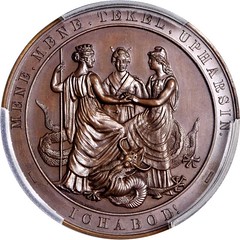 Jim Contursi writes:
Jim Contursi writes:
"I'm fairly certain that the legend on the Siege of Peking Boxer Rebellion medal – mene mene tekel upharsin –is a transliteration of (Biblical) Aramaic, not Hebrew. "
Thanks. -Editor
To read the earlier E-Sylum article, see:
SIEGE OF PEKING BOXER REBELLION MEDAL
(https://www.coinbooks.org/v24/esylum_v24n14a23.html)
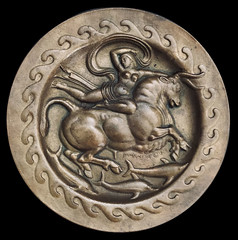 Harry Waterson writes:
Harry Waterson writes:
"This is just a short note of pure envy. I should be able to describe a medal like Bob Mueller. But I can't and I bemoan that."
Many thanks for Bob for his excellent article on the works of artist Paul Manship last week. -Editor
To read the earlier E-Sylum article, see:
MANSHIP'S DIANA AND FLIGHT OF EUROPA
(https://www.coinbooks.org/v24/esylum_v24n14a09.html)

MORE ON J.N.T. LEVICK
Dave Hirt submitted these additional thoughts on J.N.T. Levick. Thanks! -Editor
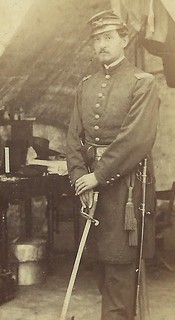 First of all I want to congratulate Pete Smith for his interesting, but sad article, "The Coin Shop Killer", published in The Numismatist magazine that I received in the mail this week.
First of all I want to congratulate Pete Smith for his interesting, but sad article, "The Coin Shop Killer", published in The Numismatist magazine that I received in the mail this week.
On the John Lupia bio of JNT Levick, he was a super collector and numismatist. it was a surprise to me that he owned the Oak and Pine Tree coins from the Roxbury hoard. The letter to Tom Elder on his house full of collectables was covered in the The E-Sylum some years ago. All I can say is that Levick must have had a very understanding wife!
The 20,000 token collection sold by Woodward in 1884 speaks for itself. He had everything! In the AJN, the report of the Jan. 1878 meeting of the Boston Numismatic Society reports that the president had received a parcel of coins belonging to JNT Levick, of many rare pieces, including a 1802 Half Dime, Threepence of Standish Berry, five varieties of Wolfe, Spies, and Clark tokens, Ricketts Circus tokens in silver and copper, Washington market chowder club token, several California private issues, and a number of other rare tokens.
Levick also sold one of his collections in 1865. That also has great material, for example US silver Proof Sets of 1842, 1847, 1856, 1858. I am lucky to have a priced and named catalog of this sale. The buyers' names are so beautifully written with a quill in blue ink that to me they are a work of art in themselves. At one point because of the printing the space to write the names is small. The name "Worthington" is written clearly in a 5/8" space!
There is a token in this sale that I can not identify. It is lot 1056 Warren & Son, Sacramento, tin, size 25. Perhaps our token collector readers can help us identify it.
The 1865 sale also had an addenda of the Levick auction catalogs, 135 lots. The earliest was in 1840. He also had 1848, and 1849 sales.
Amazing breadth of interests. Can anyone help with the Warren & Son, Sacramento token? -Editor
To read the earlier E-Sylum article, see:
J. N. T. LEVICK'S LIFETIME OF HOBBY ACCUMULATIONS
(https://www.coinbooks.org/esylum_v11n37a06.html)
JOSEPH NAPOLEON TRICOT LEVICK (1828-1908)
(https://www.coinbooks.org/v24/esylum_v24n14a11.html)
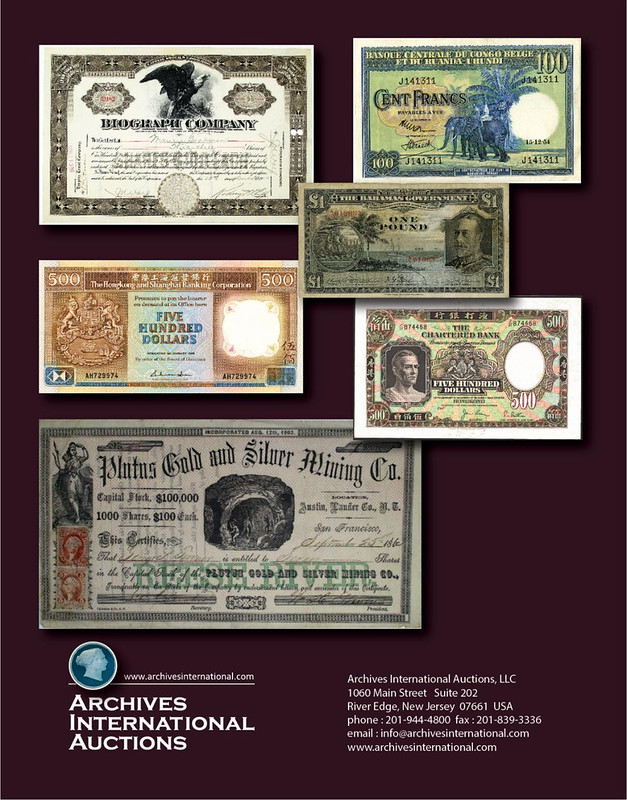
VOCABULARY TERM: DESIGN COMPETITION
Here's another entry from Dick Johnson's Encyclopedia of Coin and Medal Terminology. -Editor
Design Competition. A contest to obtain a desired coin or medal design. There are two kinds: open and closed. Anyone from the public is allowed to enter an open competition; entries come from the most competent professional artist to the most amateurish, childish contestant. A closed competition is available only to those who are so invited by the sponsor, often for a fee and irrespective of the outcome of the contest. While most professional artists refuse to enter an open contest, considering it a waste of their time and talent, they will readily accept participating in a closed competition.
Many American coins and medals have been designed by competition. The U.S. Treasury conducted such contests in the period 1892-1915 for new coin designs; by and large the search was unsuccessful. The new coin designs after this period were created by accomplished sculptor-medalists (Buffalo nickel by James Fraser, Mercury dime by Adolph Weinman, Liberty standing quarter by Hermon McNeil, Liberty walking half dollar by Weinman, Peace dollar by Anthony de Francisci). Yet another contest was held in 1937 for the new five-cent piece, resulting in the Jefferson nickel. (Even so the accepted design by Felix Schlag was dramatically modified.)
Again, in 1975, the reverse of the dollar, half and quarter for the bicentennial era coinage, were obtained by open competition. Perhaps the largest such design competition was mounted in 1974 by the Franklin Mint to obtain bicentennial medal designs for each of fifty state medals.
There are advantages and disadvantages to both types, or even using competitions at all. They do elicit public participation, but often the designs obtained are unsuitable both artistically and to the constraints of coin and medal production. They often find fresh new talent, but these artists woefully lack the technical skill to produce a satisfactory model. If an organization is willing to accept whatever it receives – and modify the design for necessary technical production – then an open competition may be used.
Otherwise commissioning a small group of experienced professional artist-medalists is preferred. If they are invited to participate, the organization must pay each, but the quality expected may be far superior. It is the duty of the organization to inspire the artists to produce their most creative work.
Competitions requiring three-dimensional models (instead of drawings) occurred in the United States for the 1932 Washington quarter and the 1939 Jefferson nickel (among others). These are somewhat questionable, since a great many contestants may waste their time creating a model without the knowledge of how to do so. Also since one is accepted, the others are returned to the artists. Often these models, the rejected designs – are put to some other use, as being reworked for a medal program, or become stock designs, or simply rest in the artist's studio until his death whereupon they come on the market and sometimes sold to collectors.
To read the complete entry on the Newman Numismatic Portal, see:
Design Competition
(https://nnp.wustl.edu/library/dictionarydetail/515704)
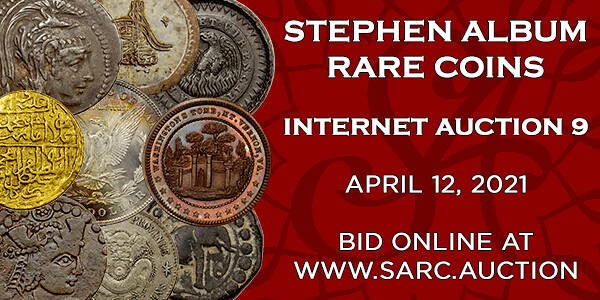
ISAIAH QUIMBY LUKENS (1779-1846)
Here's another entry from the online draft of John Lupia's book of numismatic biographies. Thanks! This is an excerpt with the full article and bibliography available online. This week's subject is Isaish Lukens of Philadelphia, an early American coin collector. -Editor
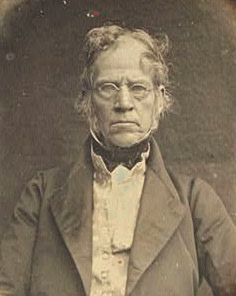 Lukens, Isaiah Quimby (1779-1846), Philadelphia inventor, machinist, gun and clock-maker. He was born at Horsham, Pennsylvania on April 24, 1779, the second son of ten children born to Seneca Iredell Lukens (1751-1829) a clockmaker and Sarah Quimby (1755-1843). His father taught him the mechanical skill and craft of being a machinist and in the fine art of clock-making.
Lukens, Isaiah Quimby (1779-1846), Philadelphia inventor, machinist, gun and clock-maker. He was born at Horsham, Pennsylvania on April 24, 1779, the second son of ten children born to Seneca Iredell Lukens (1751-1829) a clockmaker and Sarah Quimby (1755-1843). His father taught him the mechanical skill and craft of being a machinist and in the fine art of clock-making.
He made the clock for the Old State House "Independence Hall" in Philadelphia in 1828. It was removed in 1924 and installed in the new Town Hall at Germantown. He was one of the founders of the Franklin Institute, and was elected its first Vice-President.
He died of an aneurysm of the aorta on November 12, 1846, at Philadelphia, Pennsylvania. He is buried at Laurel Hill Cemetery, Philadelphia, Pennsylvania.
His estate probate record shows he left small boxes of minerals valued at $1.00, minerals in glass vials valued at $20.00, a medal in a case valued at $1.00, a box of precious stones valued at $2.00, a set of cornelian stones valued at $5.00, his library valued at $20.00, a small box of agates $2.00, a box of rubies $2.00, drawers of medals and case $20.00, agate boxes $7.50, Lot of minerals $250.00, medals of Christ $0.75, agate stamp $1.00, book & mineral cases $15.00.
There are a few Daguerreotype photographs of him by Charles Wilson Peale. His coin collection was sold posthumously by W. S. Berrell & J. S. Burr on January 4, 1847.
To read the complete article, see:
LUKENS, ISAIAH QUIMBY
(http://www.numismaticmall.com/numismaticmall-com/lukens-isaiah-quimby)

HARVEY STACK'S NUMISMATIC FAMILY, PART 93
The latest article in Harvey Stack's blog series discusses the 1984 sale of the Amon G. Carter, Jr. collection. Thanks. -Editor
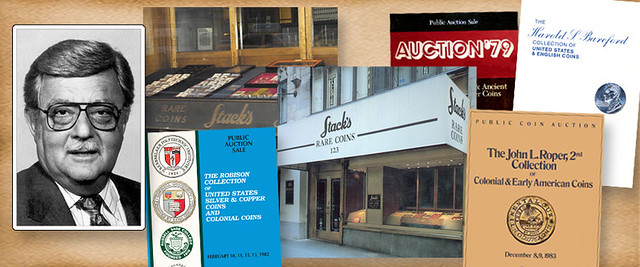
To start off our landmark auction year in 1984 Stack's presented the astounding coin collection of Amon G. Carter, Jr. This collection had been started by Amon Carter, Sr. and later enhanced by his son. The Carter family owned the Fort Worth Star Journal, was a major shareholder of American Airlines, and in 1953 the Amon Carter Field airport was opened in Fort Worth.
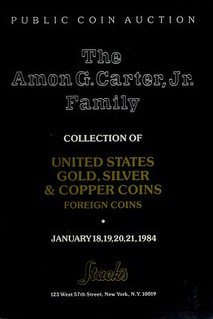 Our January sale of 1,798 lots offered sets of Proof and Mint State small cents, five-cent nickels, half dimes, dimes, quarters and half dollars. These were the earlier sets assembled by Amon, Jr. Also featured was a virtually complete set of early dollars, built with the help of Amon, Sr. This collection was highlighted by a Gem 1794, brilliant Proofs of 1801, 1802, and 1803, and the very rare 1804. The Gobrecht dollars followed, along with Liberty Seated dollars with nearly every date in Mint State or Proof. Of note were the very rare 1870-1873 Carson City silver dollars and the exceedingly rare 1870-S. The sets of Morgan and Peace dollars were complete, and the trade dollars included both the 1884 and 1885.
Our January sale of 1,798 lots offered sets of Proof and Mint State small cents, five-cent nickels, half dimes, dimes, quarters and half dollars. These were the earlier sets assembled by Amon, Jr. Also featured was a virtually complete set of early dollars, built with the help of Amon, Sr. This collection was highlighted by a Gem 1794, brilliant Proofs of 1801, 1802, and 1803, and the very rare 1804. The Gobrecht dollars followed, along with Liberty Seated dollars with nearly every date in Mint State or Proof. Of note were the very rare 1870-1873 Carson City silver dollars and the exceedingly rare 1870-S. The sets of Morgan and Peace dollars were complete, and the trade dollars included both the 1884 and 1885.
The gold coins were extremely impressive. Starting with United States gold, the collection had a full set of gold dollars (considered one of the finest ever assembled). The quarter eagles started with both types of 1796, continuing through 1808, a run from 1821 to 1836, a superb 1848 CAL, and virtually a full set of Proof issues from 1859-1907. Three-dollar gold pieces were nearly complete and included Proofs of 1875 and 1876, followed by a set of the four $4 gold Stellas and, a quintuple gold Stella!. The half eagles started with 1795 and contained most varieties through 1829, highlighted by an 1815 and an 1819. There were also most of the Proof issues from 1860 to 1915. Eagles comprised a full date set from 1795 to 1804 and a run of Proofs from 1858 to 1915, including the rare issues from 1873, 1874, 1875 and 1876. $20 double eagles were also almost complete, and featured many rarities including New Orleans coins from 1851 through 1856. The Proof double eagles featured 1861, 1864, 1867, 1868, 1869, 1873, 1874, 1875, 1876, 1882, 1883, 1884, 1885 and a number of later issues. The Saint-Gaudens series was well represented, including 1920-S, 1921, 1924-D, 1924-S, 1925-D, 1925-S, 1926-D, 1926-S, 1927-S, 1930-S, 1931, 1931-D and 1932.
One particularly notable highlight was the 1848 gold , silver and copper Proof set in its original box of issue.
The pioneer and territorial gold collection was one of the largest and most important sold at public auction and rivaled the famous Walton Collection that we had sold in 1962. It offered an outstanding number of $50 gold "slugs," with three Wass, Molitor round $50s and one round Kellogg, along with 27 octagonal slugs of all types and varieties. Other rare issues included coins of the U.S. Assay Office, Moffat & Co., Norris, Gregg & Norris, Dunbar & Co., Dubosq & Co., Wass Molitor, and the Mormons, plus many more.
Famous pedigrees represented in the Amon Carter, Jr. Family Collection included Dunham, Neil, Col. E.H.R. Green, Atwater, Olson, Roe, King Farouk, Roach, Granberg, Newcomer, Haseltine and numerous other well known collections that had been sold at public auction or private treaty during the first half of the 20th century. This trend of desirable pedigrees would carry through to many of the other fine collections sold by Stack's in 1984.
The Amon Carter, Jr. Collection was a great way for Stack's to start off the year, but there was no time for us to rest, as our March sale brought to the auction block Part 2 of the collection of Americana formed by the late John L. Roper of Norfolk, Virginia.
To read the complete article, see:
Harvey Stack Remembers: Growing up in a Numismatic Family, Part 93
(https://www.stacksbowers.com/News/Pages/Blogs.aspx?ArticleID=harvey-stack-remembers-part-93)
To read the earlier E-Sylum article, see:
HARVEY STACK'S NUMISMATIC FAMILY, PART 92
(https://www.coinbooks.org/v24/esylum_v24n13a15.html)

NATANYA VAN NIEKERK ACHIEVEMENT AWARD
The Lifetime Achievement Award in Coin Design is given annually as part of Coin of the Year awards program recognizing excellence and ingenuity in coin design. A Numismatic News article by Tom Michael discusses this year's winner Natanya Van Niekerk. Here's an excerpt, but be sure to read the complete article online. -Editor
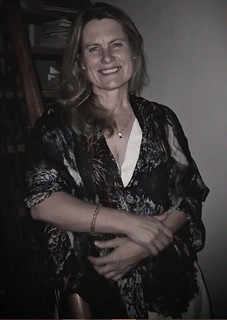 After 27 years of experience in the coin and bullion industry, Natanya Van Niekerk has left her distinctive artistic mark on both legal tender coins and investment bullion pieces. She has experienced the inner workings of our industry at the national mint, private mint and refinery levels. The constant in each of those channels was that Van Niekerk pursued a holistic approach to precious metal design, combining politics, environment and art.
After 27 years of experience in the coin and bullion industry, Natanya Van Niekerk has left her distinctive artistic mark on both legal tender coins and investment bullion pieces. She has experienced the inner workings of our industry at the national mint, private mint and refinery levels. The constant in each of those channels was that Van Niekerk pursued a holistic approach to precious metal design, combining politics, environment and art.
This approach guided Van Niekerk in the creation of almost 20 award-winning coin designs, from 1996 to 2013, including nine Mint Directors Conference (MDC) awards and three Coin of the Year (COTY) category awards, two of which went on to win the overall COTY in the 1999 and 2011 competitions. But this recognition did not appear overnight, as Van Niekerk reminded us in her acceptance speech for the 2021 COTY Lifetime Achievement Award in Coin Design, her career has been a process.
"My training in fine arts did not prepare me for the miniature world of coin art and engraving, but it did give me a sense of visual history and a solid background for design. I had to learn the modern techniques and computer graphics after my formal studies. Along the way, modeling in clay made way for ArtCam and digital scanning. Rotating pantographs were sold on auction to make space for CNC engraving and laser equipment."
A South African from birth, Van Niekerk's career in coinage began at a pivotal time for her country. She drew inspiration from current political events and eventually from the environment of her homeland.
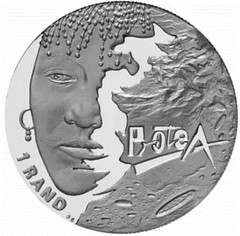
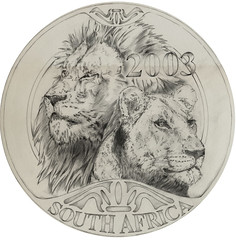
"I was born in South Africa and started my career at the South African Mint three weeks after Nelson Mandela took the Presidential oath. It was a theatrical time and a couple of golden years within the New South Africa followed. We were in an industry that had to capture these exciting times in precious metal. We told stories and saw the change from the ‘Old South Africa' to the ‘New South Africa,' to where we are today."
These changes are reflected in Van Niekerk's award-winning coin designs. Her first overall COTY winner focuses on the Women of South Africa through an extremely emotive design. While comprising half the population, women were at that time "one of the most marginalized and vulnerable groups in the country," to quote Waheeda Amien of the University of South Africa.
To read the complete article, see:
Natanya Van Niekerk Receives COTY Lifetime Achievement Award
(https://www.numismaticnews.net/coin-of-the-year/natanya-van-niekerk-receives-coty-lifetime-achievement-award)
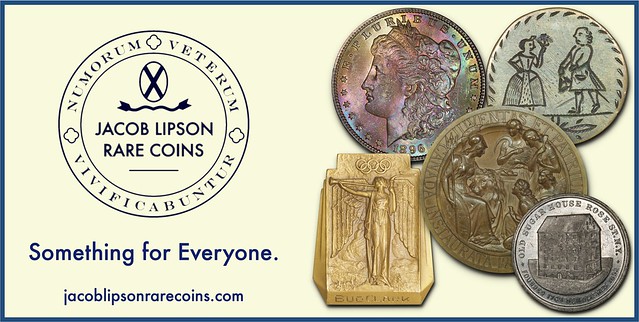
THE NUMISMATIC MUSEUM OF ATHENS
For those itching to plan some post-pandemic travel, here's something for numismatists to consider - the numismatic museum in Athens, Greece. From the Greek City Times. -Editor
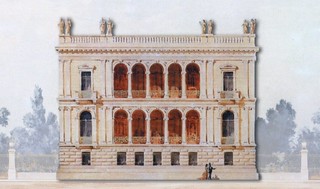 A priceless treasure in the heart of Athens, the Numismatic Museum pays tribute to Greece's integral role in the intricate history of coinage, serving as a key source of information on matters of economy from antiquity and beyond.
A priceless treasure in the heart of Athens, the Numismatic Museum pays tribute to Greece's integral role in the intricate history of coinage, serving as a key source of information on matters of economy from antiquity and beyond.
Housing a collection of over 500,000 coins, medals, gems, weights, stamps and related artefacts from the 14th century BC to modern times, this collection constitutes one of the richest in the world, paralleled by those of the British Museum in London, the Bibliothèque Nationale in Paris, the State Hermitage Museum in St. Petersburg, the Bode Museum in Berlin, and the American Numismatic Society in New York.
Undoubtedly, the museum's most stunning collections are those of ancient city states, the Hellenistic world, and the Roman Republic, dated from the 6th century BC to the 5th century AD.
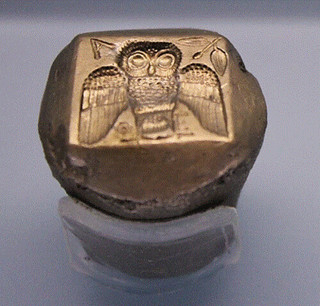 Its collection of Byzantine and Medieval coins from Eastern Europe and the Ottoman Empire, dated from the 6th century AD to the 15th century AD, are of equal importance and highly impressive.
Its collection of Byzantine and Medieval coins from Eastern Europe and the Ottoman Empire, dated from the 6th century AD to the 15th century AD, are of equal importance and highly impressive.
The numismatic collection of Greece has its roots in 1829 on the Argo-Saronic island of Aegina, when the newly founded Greek state created conditions inviting the protection of national cultural heritage. Thus began the first organised coin collecting efforts in Greece.
Comprised of a total of 329 coins, Greece's first national numismatic collection was instituted in 1834, along with the inaugural National Archaeological Museum. Gradually augmented by donations, confiscations, purchases, and excavations from Olympia, Delphi, Corinth and other major archeological sites, the museum's collection topped 50,000 coins in the 1970s.
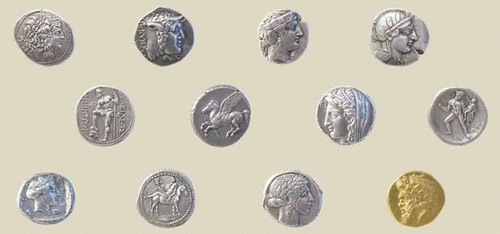
Today, the Numismatic Museum holds more than 190,000 pieces of currency sourced from some 670 ancient Greek, Roman, Byzantine, Medieval and Modern hoards discovered in Greece. Host to a conservation laboratory, as well as a library of some 12,500 publications dedicated to the study of coinage, the Numismatic Museum is housed in the magnificent neoclassical Iliou Melathron, originally erected in 1878 as the private residence of prominent businessman and archaeologist Heinrich Schliemann.
To read the complete article, see:
The Numismatic Museum in Athens
(https://greekcitytimes.com/2021/04/09/numismatic-museum-athens/)
For more information, see:
Numismatic Museum of Athens
(https://museu.ms/museum/details/877/numismatic-museum-of-athens)
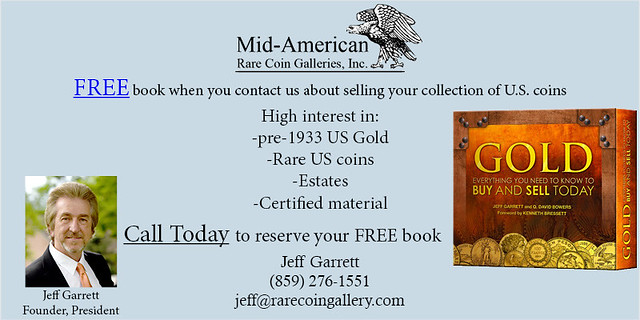
ALBUM APRIL 2021 E-AUCTION 9
Here's the press release for the April 2021 E-Auction 9 sale from Stephen Album Rare Coins. Get your bids in quick! -Editor
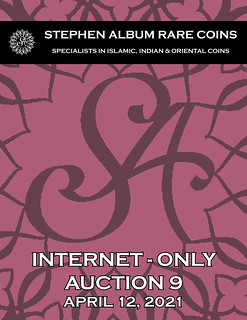 Stephen Album Rare Coins will hold its Internet Auction 9 on April 12, 2021. The firm has plans to conduct monthly internet auctions each of the 9 months of the year when its larger floor auctions are not being held. The larger sales are routinely held in January, May and September.
Stephen Album Rare Coins will hold its Internet Auction 9 on April 12, 2021. The firm has plans to conduct monthly internet auctions each of the 9 months of the year when its larger floor auctions are not being held. The larger sales are routinely held in January, May and September.
Pre-sale bidding has already begun and will continue through April 12. At that point it will be possible to bid live online to compete with others bidders for the offerings. The auction is made up of exactly 600 lots of Ancient, Islamic, Chinese, General World, and Indian Coins, with starting prices from $25 to $1,600.
Various selections from the sale from across the price spectrum follow:
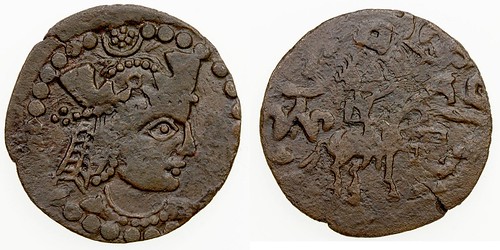
LOT 15: ANCIENT: CHORESMIA: Kanik, early 8th century, AE unit (5.82g), Vainberg G4.8, cf. Zeno-109706, bust right, wearing diademed crown topped with crescent and necklace // horseman right, holding whip, tamgha behind, legends around, fantastic bold portrait, choice VF-EF, ex Ralph A Cannito Collection. Starting bid $90
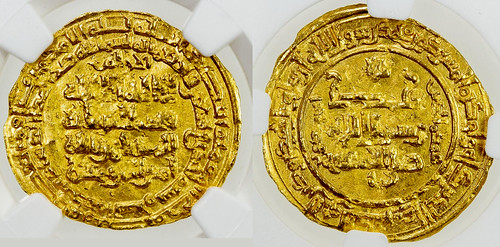
LOT 24: ISLAMIC: ABBASID: al-Mustazhir, 1094-1118, AV dinar (3.49g), Madinat al-Salam, AH491, A-B266, a lovely lustrous mint state example! NGC graded MS63, RR. Starting bid $1,600
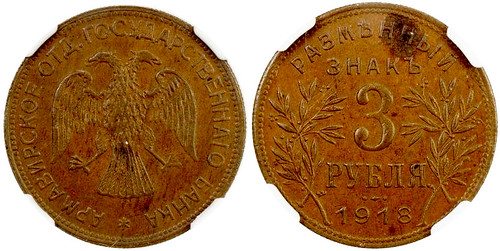
LOT 445: WORLD: RUSSIA: ARMAVIR: AE 3 roubles, 1918, KM-2.1, Bitkin-7, variety with monogram below tail, well struck, one-year type, NGC graded MS62 BN. Starting bid $700
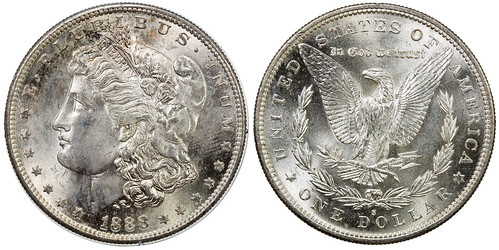
LOT 499: WORLD: UNITED STATES: AR dollar, 1888-S, KM-110, PCGS graded MS63, old "rattler" PCGS holder, light obverse toning. Starting bid $300

LOT 530: CHINA: KIANGNAN: Kuang Hsu, 1875-1908, AR 20 cents, CD1901, Y-143a.6, L&M-238, AU. Starting bid $40
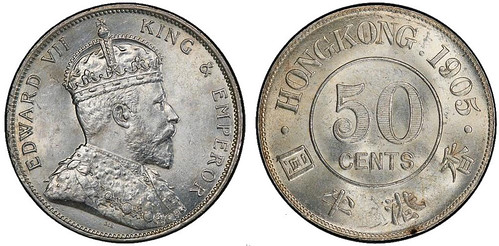
LOT 543: CHINA: HONG KONG: Edward VII, 1901-1910, AR 50 cents, 1905, KM-15, a pleasing mint state example! PCGS graded MS62. Starting bid $200
The lots can be viewed at www.sarc.auction
Following this internet sale the firm will hold its Auction 40 on May 13-15, 2021 in Santa Rosa.
The catalog can be found on their website. Subsequent internet auctions will be held in mid-June, mid-July and mid-August. The firm is also now taking consignments until July 1, 2021 for its Auction 41 which will be held in September.
More information can be found on their website at www.stevealbum.com

NUMISMATIC NUGGETS: APRIL 11, 2021
Here's a selection of interesting or unusual items I came across in the marketplace this week. Tell us what you think of some of these. -Editor
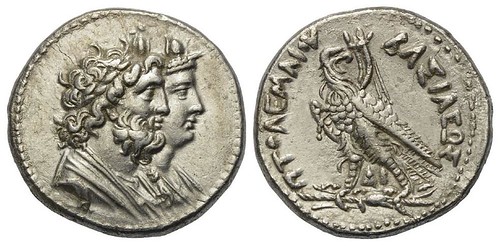
Lot 1167. Ptolemaic Kingdom. Ptolemy IV Philopator (221-205 BC).
Tetradrachm (silver). After 217 BC Chr. Alexandria. Vs: The draped busts of Zeus Serapis with a laurel wreath, Tainia and Atef crown and Isis with a wreath of ears and a crown side by side on the right. Rs: eagle with flared wings and double horn of plenty standing on lightning bundle to the left, head turned to the right; between the legs delta-iota.
Above is the Google-translated version of the lot description. Great double bust. -Editor
To read the complete lot description, see:
Lot 1167. Ptolemäisches Königreich. Ptolemaios IV. Philopator (221 - 205 v. Chr.).
(https://www.sixbid.com/en/solidus-numismatik/8353/griechische-mnzen/6920493/ptolemisches-knigreich-ptolemaios-iv-philopator)
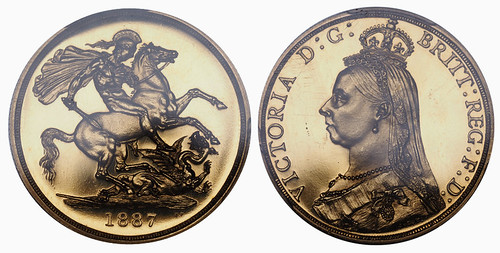
UNITED KINGDOM Proof Victoria, 1837-1901. 2 pounds 1887, London. Jubilee head. In US plastic holders of PCGS with the rating PR 62 CAM
From Muenzenonline Live Auction. Beautiful coin, picturing the great-great-grandmother of BOTH Queen Elizabeth II and her late husband Prince Philip. -Editor
To read the complete lot description, see:
LOT.NO:112 Great Britain 1887
(https://www.muenzenonline-auktion.ch/catalogDetail/detail/live-auction-no.-14-part-i-1612786195/Great-Britain-1887-564489)
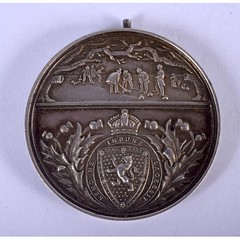
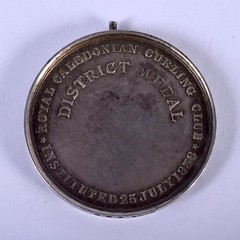
AN ANTIQUE CURLING CLUB MEDAL. Birmingham 1908. 27 grams. 4 cm diameter.
From Hannam's Auctioneers. Not often one sees a curling club medal. -Editor
To read the complete lot description, see:
AN ANTIQUE CURLING CLUB MEDAL. Birmingham 1908. 27 grams. 4 ...
(https://www.easyliveauction.com/catalogue/lot/
bd0dfdc4dda0f245cd7cfc7986e9777a/1f1638c9faeb7c2641b7b1e9c67628d0/
fine-antiques-oriental-works-of-art-lot-1098/)
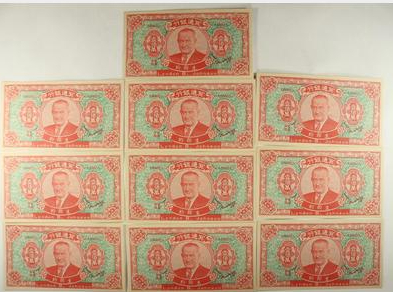
We've all heard of Chinese Hell Banknotes, designed to be burned to honor the dead. But Hell Banknotes picturing U.S. President Lyndon B. Johnson? Apparently these 1960s-era notes are also known with images of Eisenhower, Kennedy, Stalin, Khruschev and Harold Wilson. What, no Richard Nixon? -Editor
To read the complete lot description, see:
10 CHINESE HELL BANK NOTES CRISP UNC
(https://auctions.bidalotcoinauction.com/lots/view/1-4FHIWG/10-chinese-hell-bank-notes-crisp-unc)
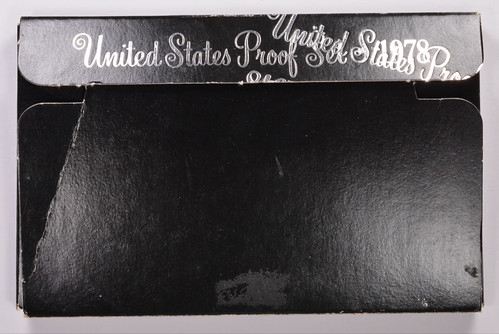
1978-S proof set with an off-center double-printing error on the front of the packaging. Unusual and scarce.
In the horse-of-a-different-color department, here's something you don't see every day - an off-center double printed proof set box label. From the stock of error dealer Jon Sullivan; a small number of these oddball items are available. -Editor
To read the complete lot description, see:
1978-s proof set off-center double-printed
(https://www.sullivannumismatics.com/coin/1978-s-proof-set-center-double-printed?v=7147)
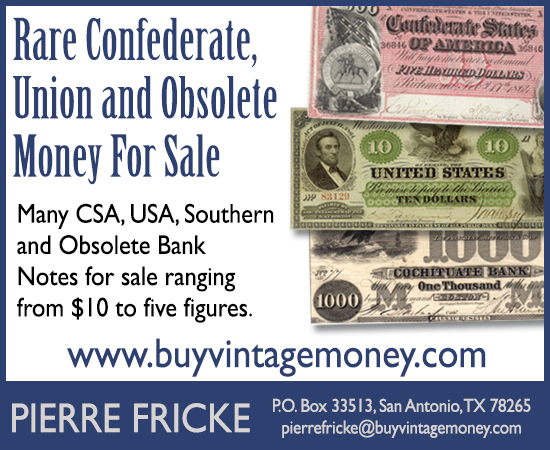
THE COINAGE OF ANCIENT MAURETANIA
Mike Markowitz has published another great article in his CoinWeek Ancient Coin Series. There's always much to learn from his well-researched pieces, and the great images are a delight, whether one collects ancient coinage or not. Here's a short excerpt - be sure to see the complete article online. -Editor
ANCIENT MAURETANIA WAS a region of coastal North Africa stretching from modern-day Algeria to Morocco. It should not be confused with the modern West African nation of Mauritania (spelled differently). The inhabitants of Mauretania were ancestors of the modern people known as Berbers. The Greeks knew them as Mauroi (?a????). To the Romans, they were Mauri. This term comes into English as "Moor", a name that has been applied to a variety of African people; for example, Shakespeare's Othello, the "Moor of Venice."
Bocchus I
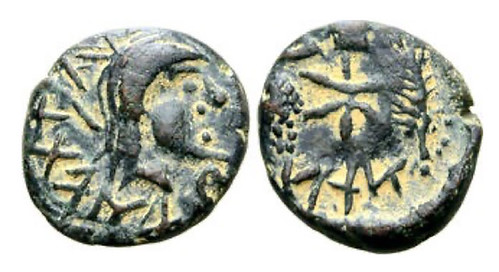
The earliest king of Mauretania known to history was Baga, who ruled c.225 BCE from his capital of Chellah (near Rabat, Morocco). The first ruler for whom we have coins was probably Bocchus (or Boccus), who reigned from about 111 to 80 BCE. Some very crude bronze coins are attributed to Bocchus (or possibly his son). A "half unit" of 4.5 grams shows a long-haired bearded head in profile on the obverse and a star between a cluster of grapes and an ear of grain on the reverse. A "unit" of about 9.4 grams shows the same obverse portrait, with a standing figure on the reverse.
Camarata
Some Mauretanian coins are attributed by city rather than ruler, and they can only be dated approximately – "late 2nd – 1st century BCE", for example. An example from Camarata[7] (km' in Punic) bears the same crude male head on the obverse and a cluster of grapes and an ear of grain on the reverse.
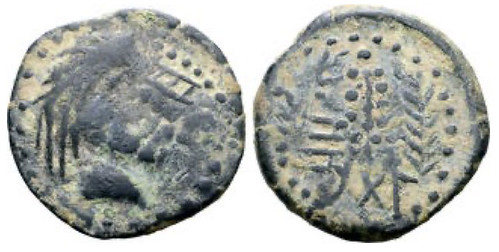
Collecting Mauretania
The standard reference for the ancient coinage of Mauretania is Mazard (1955) in French. Long out of print, second-hand copies sell for as much as $250-300, with a later paperback reprint occasionally going for much less. Jean Mazard (1900-1984) was a jurist and numismatist who lived in Algeria and assembled an extensive collection of ancient North African coins. An even earlier work, Müller (1862), is still cited in auction catalog listings.
Many royal Mauretanian coins that appear on the market today derive from a single huge hoard of some 4,000 silver pieces buried c. 17-18 CE near Souk el-Arbaa, Morocco. The "Banasa/El Ksar Hoard" was discovered in 1907 and dispersed to various museums and private (mostly French) collections.
To read the complete article, see:
The Coinage of Ancient Mauretania
(https://coinweek.com/ancient-coins/the-coinage-of-ancient-mauretania/)
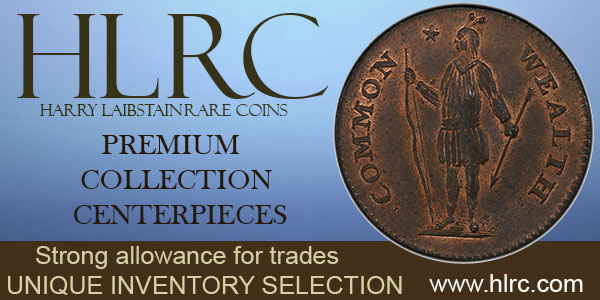
GLACIER ICE SAMPLES TRACK SILVER COIN USE
Len Augsburger passed along this 2018 Science Magazine article about the darkest hours of the Dark Ages. -Editor
Ask medieval historian Michael McCormick what year was the worst to be alive, and he's got an answer: "536." Not 1349, when the Black Death wiped out half of Europe. Not 1918, when the flu killed 50 million to 100 million people, mostly young adults. But 536. In Europe, "It was the beginning of one of the worst periods to be alive, if not the worst year," says McCormick, a historian and archaeologist who chairs the Harvard University Initiative for the Science of the Human Past.
A mysterious fog plunged Europe, the Middle East, and parts of Asia into darkness, day and night—for 18 months. "For the sun gave forth its light without brightness, like the moon, during the whole year," wrote Byzantine historian Procopius. Temperatures in the summer of 536 fell 1.5°C to 2.5°C, initiating the coldest decade in the past 2300 years. Snow fell that summer in China; crops failed; people starved. The Irish chronicles record "a failure of bread from the years 536–539." Then, in 541, bubonic plague struck the Roman port of Pelusium, in Egypt. What came to be called the Plague of Justinian spread rapidly, wiping out one-third to one-half of the population of the eastern Roman Empire and hastening its collapse, McCormick says.The numismatic connection? Analysis of ice from a Swiss glacier tracks the emergence of silver mining and the use of silver in coinage. -Editor
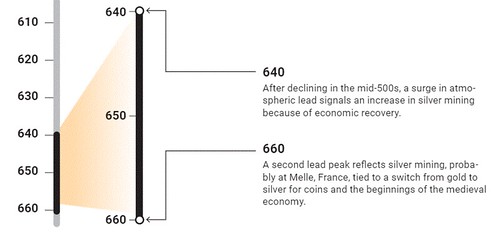
Silver was smelted from lead ore, so the lead is a sign that the precious metal was in demand in an economy rebounding from the blow a century before, says archaeologist Christopher Loveluck of the University of Nottingham in the United Kingdom. A second lead peak, in 660, marks a major infusion of silver into the emergent medieval economy. It suggests gold had become scarce as trade increased, forcing a shift to silver as the monetary standard, Loveluck and his colleagues write in Antiquity. "It shows the rise of the merchant class for the first time," he says.
Still later, the ice is a window into another dark period. Lead vanished from the air during the Black Death from 1349 to 1353, revealing an economy that had again ground to a halt. "We've entered a new era with this ability to integrate ultra–high-resolution environmental records with similarly high resolution historical records," Loveluck says. "It's a real game changer."
To read the complete article, see:
Why 536 was ‘the worst year to be alive'
(https://www.sciencemag.org/news/2018/11/why-536-was-worst-year-be-alive)
THE BOOK BAZARRE
MEDIEVAL HOARDS FOUND IN WALES
Here's a story of some interesting small hoard finds in Wales. Cool skull ring. Found via The Explorator newsletter. To subscribe to Explorator, send a blank email message to: explorator+subscribe@groups.io. -Editor
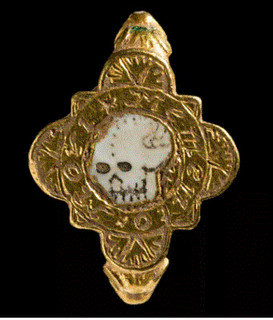 Metal detectorists in Wales have unearthed nine priceless valuables dating to the medieval and post-medieval periods, including a gold ring decorated with a spooky-looking skull crafted from white enamel.
Metal detectorists in Wales have unearthed nine priceless valuables dating to the medieval and post-medieval periods, including a gold ring decorated with a spooky-looking skull crafted from white enamel.
After analyzing the curios, Graeme David Hughes, the senior coroner for South Wales Central in the United Kingdom, officially declared them to be "treasures," a term that refers to bonafide, often metal artifacts that meet a specific archaeological criteria, according to the U.K.'s Portable Antiquities Scheme.
In all, these treasures include three hoards of gold and silver coins, gold and silver rings, and personal items worn by upper-class members of Welsh society from the ninth to the 17th centuries A.D., according to a statement from the Amgueddfa Cymru — National Museum Wales released March 29.
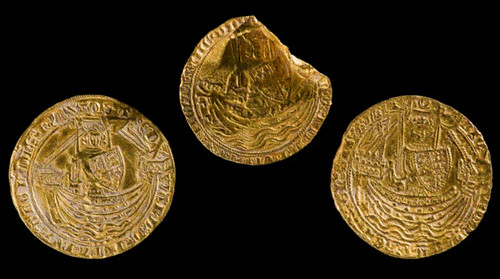
Metal detectorists Chris Perkins and Shawn Hendry discovered one of the hoards — three medieval gold coins — in the Welsh community of Llanwrtyd in April 2019. The gold coins, known as "nobles," were minted between 1327 to 1399, during the reign of Edward III and his successor Richard II. Back then, the three coins had a total worth of 20 shillings, the equivalent of 50 days' wages earned by a skilled tradesman.
It's likely that these coins were buried for safekeeping near the end of the 14th century and for some unknown reason were never recovered, according to the statement.
Another hoard included five silver coins — four groats (the name of now-defunct coins worth 4 pence) and a "double patard" coin from the Duchy of Burgundy in mainland Europe. These coins, discovered by Aled Roberts and Graham Wood in the community of Churchstoke in May 2019, were buried during the reign of Henry VIII in about 1530. The king's face even graces three of the coins, archaeologists noted.
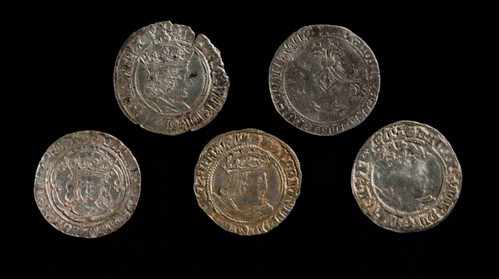
To read the complete article, see:
Medieval gold coin hoards and skull ring discovered in Wales
(https://www.livescience.com/uk-metal-detector-medieval-treasures.html)

THE 1866 NO MOTTO SEATED LIBERTY DOLLAR
David Stone of Heritage Auction published a nice article on the 1866 No Motto Seated Liberty dollar. Reprinted with permission from The Intelligent Collector magazine (IntelligentCollector.com) - Spring 2021 issue. Thanks! -Editor
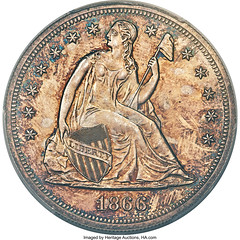
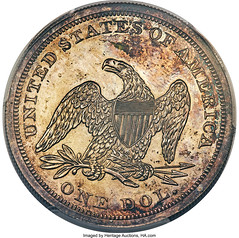
With only two examples known to collectors today, the 1866 No Motto Seated Liberty dollar is so rare that most collectors tend to overlook the issue. When discussing the rarest and most valuable U.S. coins, the conversation usually focuses on more famous issues, like the 1804 dollar (15 examples known), the 1913 Liberty nickel (five specimens extant) or the 1894-S Barber dime (nine survivors known). The much more elusive 1866 No Motto dollar is seldom mentioned, as its public offerings occur so infrequently that the coin remains out-of-sight and out-of-mind for most collectors. Its availability is further diminished because one of the two known specimens is impounded in the National Numismatic Collection at the Smithsonian Institution, where no collector will ever acquire it.
Against this backdrop of relative anonymity, Heritage Auctions is offering the only available example of this overlooked rarity in its April 2021 catalog of Important Selections from the Bob R. Simpson Collection, Part V. Hopefully, this high-visibility appearance will increase collector interest in the 1866 No Motto dollar, one of the rarest issues in American coinage.
‘TRANSITIONAL' PATTERNS
The motto IN GOD WE TRUST was added to the design of the
regular-issue Seated Liberty dollar, half dollar and quarter in
1866. At some point, early pattern specialist Robert Coulton
Davis obtained a set of the three silver denominations dated 1866
that were struck without the motto. The coins were reportedly
"transitional" patterns, struck before the design change took
place, but most numismatists agree they were actually
fantasy pieces, struck specifically for sale to Davis.
Interestingly, Dick Osburn and Brian Cushing
have identified the obverse die as the same
one used to strike some proof With Motto
Seated Liberty dollars in 1866 (the OCP2 variety). Similarly, they identify the
reverse die as the same one used to
strike some extremely rare proof 1865
Seated Liberty dollars (the OC-P1
variety). The dies appear to be in
the same state during all these uses.
Since both obverse and reverse dies
were on hand in the Mint in 1866, it
is possible that the 1866 No Motto
dollars were actually struck that
year, but most numismatists believe
they were struck later, in the 1869-
1870 time frame.
Chief Coiner Archibald Loudon Snowden was probably the man who struck the 1866 No Motto coins for Davis. He seems to have liked the idea so much that he struck a second example of the dollar for himself. Snowden acquired a massive collection of patterns and other rarities during his service at the Mint, which lasted for decades. He was able to purchase the coins by exchanging an equivalent value in coins or bullion for them, a practice that remained legal for Mint employees until the 1930s.
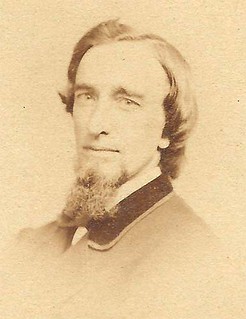 R.C. Davis retained his set of No Motto coins for many
years, but the set was split up after his death in 1888. The
coins followed different paths until Willis duPont succeeded in
rejoining them all in 1961. The set was stolen, along with the rest
of duPont's collection, in a daring armed robbery in 1967. All
three coins were eventually recovered and returned to duPont,
with the dollar being the last to surface in 2004. Afterward, the
set was exhibited at the ANA Money Museum for an extended
period before being donated to the National Numismatic
Collection in 2014.
R.C. Davis retained his set of No Motto coins for many
years, but the set was split up after his death in 1888. The
coins followed different paths until Willis duPont succeeded in
rejoining them all in 1961. The set was stolen, along with the rest
of duPont's collection, in a daring armed robbery in 1967. All
three coins were eventually recovered and returned to duPont,
with the dollar being the last to surface in 2004. Afterward, the
set was exhibited at the ANA Money Museum for an extended
period before being donated to the National Numismatic
Collection in 2014.
Snowden's dollar has an equally interesting history. Snowden held on to his hoard of rarities until long after he retired, but he began selling off some of his coins in the early 20th century. His most notable transaction involved the two 1877 fifty-dollar Half Union patterns in gold, which he sold to prominent collector William H. Woodin for the unheard-of price of $20,000, through John W. Haseltine and Stephen Nagy. The public became aware of this transaction, due to some articles Edgar Adams published in The Numismatist, and a strong feeling developed that the coins should never have been released from government holdings. After much legal maneuvering, Woodin agreed to return the Half Unions to the Mint, Snowden kept the money, but surrendered his hoard of numismatic treasures to Woodin in exchange. In this manner, Woodin acquired examples of more than half the patterns listed in the Adams-Woodin pattern reference that was published in 1913, several 1884 Trade dollars, all five 1885 Trade dollars and many other rarities, including Snowden's 1866 No Motto dollar.
FAMOUS COLLECTIONS
Like many collectors over the years, William Woodin seems to
have underrated the 1866 No Motto dollar, as he soon sold it to
H.O. Granberg, along with the No Motto quarter and half dollar
he had acquired earlier. The new set was exhibited at the 1914
ANS Exhibition and later passed through the famous collections
of F.C.C. Boyd, "Colonel" Green and King Farouk, before
being split up again (the quarter and half dollar were eventually
acquired by duPont, to reconstitute the set). The Snowden dollar then appeared in a string of Stack's auctions in the 1960s, and
was finally featured in lot 31 of the Kennywood Collection
(American Numismatic Rarities, 1/2005), which realized a
substantial $1,207,500. The coin has been in Bob Simpson's
remarkable collection ever since.
Designated Judd-540 in the leading pattern reference, the 1866 No Motto Seated Liberty dollar is a sought-after prize for advanced collectors of patterns and Seated Liberty dollars alike.
Dave notes that the photo of Robert Coulton Davis is courtesy of Pete Smith and The E-Sylum. Looked familiar! -Editor
To read the earlier E-Sylum article, see:
QUIZ ANSWER: ROBERT COULTON DAVIS
(https://www.coinbooks.org/esylum_v15n10a08.html)

CORNING MAKES GLASS COVID-19 COINS
Nick Graver of Rochester, NY passed along this article about the Corning Museum's new glass challenge coins to celebrate the National Guard campaign over the making of the glass vials that hold the Covid Vaccine. Thanks! -Editor
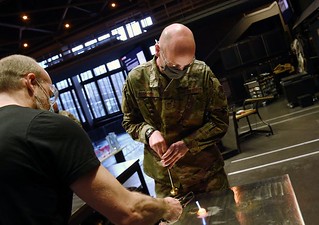 Corning Inc. is a major player in the battle to defeat the COVID-19 pandemic, and the New York Army National Guard is manning a state-run regional vaccination center at SUNY Corning Community College.
Corning Inc. is a major player in the battle to defeat the COVID-19 pandemic, and the New York Army National Guard is manning a state-run regional vaccination center at SUNY Corning Community College.
Now the Corning Museum of Glass is creating a special commemorative coin to honor both of those efforts.
"Challenge coins" have a long tradition in military history and among first responders as a way to honor units involved in special missions.
Sgt. Jason Borghi, of Niagara Falls, who is in charge of the National Guard unit operating the CCC vaccination center, noted that Corning Inc. manufactures the Valor Glass vials used to store and transport much of the COVID-19 vaccine being distributed in the United States.
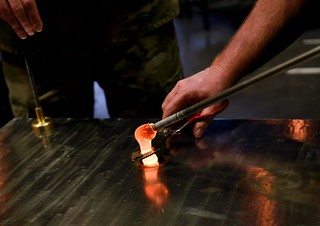 Borghi thought it was a natural connection and he reached out to the Corning Museum of Glass to see if it would be possible to create a challenge coin out of glass.
Borghi thought it was a natural connection and he reached out to the Corning Museum of Glass to see if it would be possible to create a challenge coin out of glass.
The museum readily agreed.
"This is the first vaccination site in the state run by the National Guard. We're super excited. The vials we use here were made in Corning," Borghi said. "The vaccine is what is going to be what gets us out of this. Usually we do patches or some metallic coin. This was a different opportunity. I'm not aware of any other glass coins out there."
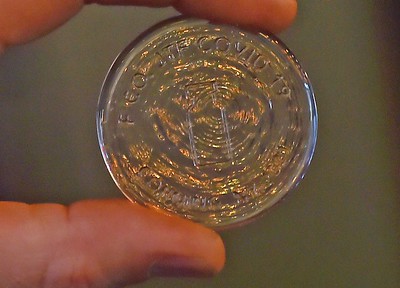
Me neither - I've not heard of any other challenge coins made of glass. Very interesting. Only 120 are being made, so these will be a rarity. -Editor
To read the complete article, see:
Corning museum creates glass 'challenge coins' to celebrate National Guard vaccine mission
(https://www.stargazette.com/story/news/local/2021/04/09/corning-museum-glass-honors-national-guard-covid-19-mission-coins/7121759002/)
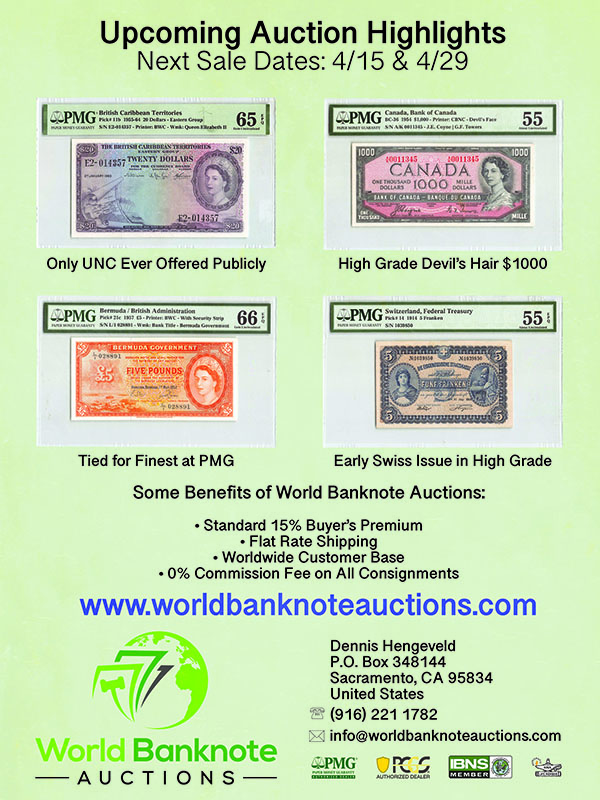
THE HISTORY OF INDIA'S PAPER MONEY
This article from the Hindistan Times seems like a nice overview of the history of the paper money of India, along with some insight on Britain's experience with its American colonies. Found via News & Notes from the Society of Paper Money Collectors (Volume VI, Number 41 March 30, 2021). -Editor
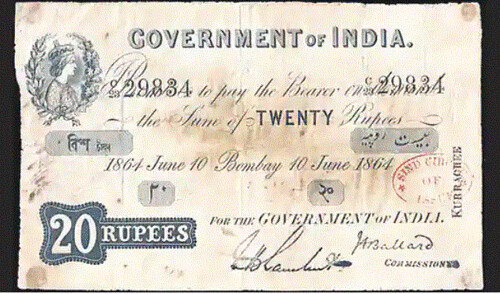
1864 Government of India 20 Rupees note
Indian paper money is 160 years old this month. See how an act meant to tighten British control ended up uniting us in spirit, then and even today.
Open your wallet and sing Happy Birthday. Indian paper money is 160 years old this month. Our distinctive series of notes — which today bear the name of the Reserve Bank of India, feature a portrait of Mahatma Gandhi, and effortlessly represent rupees within India and abroad — didn't exist before 1861.
Of course, we had money long before that. India is one of the first regions in the world to have used coins. Metal bits of various values, issued by local empires, kingdoms, princely states and colonial presidencies, have been circulating for more than 2,600 years. But notes — paper scraps that somehow have the power to make you rich or poor — are relatively recent. They were born with the Paper Currency Act of 1861, which gave the British colonial government the sole right to issue uniform currency notes for its territories in India (which included parts of present-day Pakistan, Bangladesh and Burma).
In a country where paper currency was a very small part of the monetary system, the notes represented not just a new way of doing business. They were a leap of faith.
The British Empire had attempted to impose a currency monopoly a century earlier, in another dominion, with disastrous consequences. In the 13 colonies of British America, where a trade deficit had already put American businesses at a disadvantage, a currency act in 1764 rendered money from local banks useless.
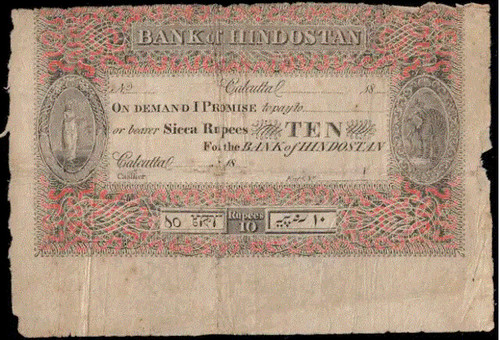
Bank of Hindustan 10 Rupees note
The colonies protested vehemently. "It was seen by some as one of the many triggers that sparked the American Revolution," says Bazil Shaikh, former principal chief general manager and secretary of the Reserve Bank of India, and author of the 2020 book The Conjuror's Trick, about the evolution of Indian paper money.
In India a century later, another revolution, the Uprising of 1857-58, had shaken the British. They were heavily in debt from quelling the uprising. "When the Crown took control of India from the East India Company, the question arose, ‘Who repays the debts?' It was made clear that India would pay for its own suppression," says Shaikh. "The profit from the introduction of a government paper currency was seen as one of the means of setting right India's finances."
The article also describes Rezwan Razack's collection of Indian banknotes, discusses in an earlier E-Sylum. -Editor
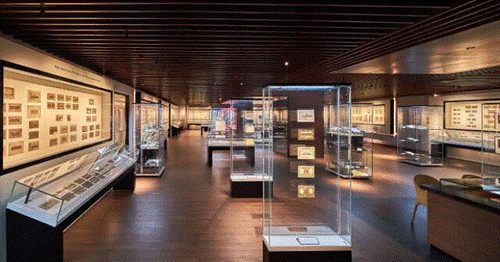
The way he tells it, the Bengaluru tycoon was born into money, and learnt early that it was valuable in more ways than one. As a schoolkid more than 50 years ago, he'd watch his parents and grandparents place the day's collections in the family safe at night.
"I decided to explore that safe one day," he recalls. "What I found were a handful of notes that said Reserve Bank of India but also bore the overprint "Pakistan". I showed them to my grandfather who immediately started cursing."
It turned out that the notes were interim currency issued for use in Pakistan just after Partition, before the State Bank of Pakistan was established. They were probably passed on by someone who had crossed the border with the money, but they had no value in India.
"I asked my grandfather if I could have them. He happily gave them to me, plus some other old notes," he says. "Then, on a summer holiday at my uncle's home in Coonoor, I found more old notes in my uncle's desk and was allowed to keep them. And so my journey began."
To read the complete article, see:
Cash of the titans: How India's paper money came to be
(https://www.hindustantimes.com/lifestyle/art-culture/cash-of-the-titans-how-india-s-paper-money-came-to-be-101616764415186.html)
To read the earlier E-Sylum articles, see:
MUSEUM OF INDIAN PAPER MONEY
(https://www.coinbooks.org/v23/esylum_v23n09a22.html)
THE MUSEUM OF INDIAN PAPER MONEY
(https://www.coinbooks.org/v23/esylum_v23n21a31.html)

BANKNOTE EMBROIDERY AS POLITICAL ART
There are nearly as many forms of Money Art as there are Money Artists like my old friend J.S.G. Boggs. This article from The Guardian introduced me to something I hadn't heard of before - embroidered banknotes. Interesting concept. Here are some designs that caught my eye - see the complete article for more. -Editor
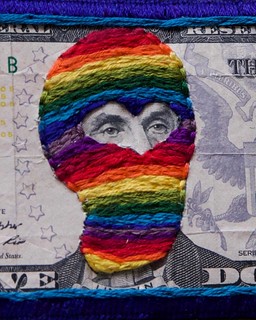 American artist Stacey Lee Webber has embroidered money for more than a decade. She started as a way to question the value of work by meticulously stitching patterns on to worthless one dollar bills. The latest incarnation – the Insurrection Bills – is a response to the US's febrile political climate.
American artist Stacey Lee Webber has embroidered money for more than a decade. She started as a way to question the value of work by meticulously stitching patterns on to worthless one dollar bills. The latest incarnation – the Insurrection Bills – is a response to the US's febrile political climate.
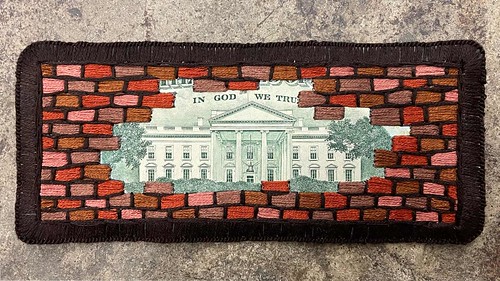
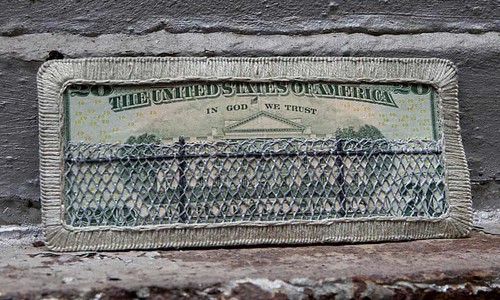
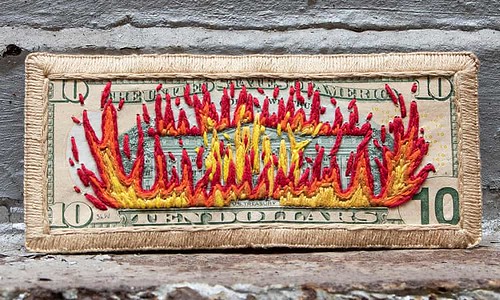
To read the complete article, see:
Banknote embroidery as political art – in pictures
(https://www.theguardian.com/lifeandstyle/gallery/2021/apr/10/banknote-embroidery-as-political-art-in-pictures)

LOOSE CHANGE: APRIL 11, 2021
Here are some additional items in the media this week that may be of interest. -Editor
Canadian Coin News reports that the Ontario Numismatic Association will hold a numismatic symposium online. -Editor
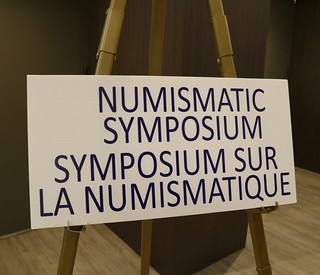 The Ontario Numismatic Association (ONA) will host its first virtual convention on April 9-11, the same dates as the since-cancelled in-person gathering originally slated for Burlington.
The Ontario Numismatic Association (ONA) will host its first virtual convention on April 9-11, the same dates as the since-cancelled in-person gathering originally slated for Burlington.
The decision to move the three-day convention to a digital format came in mid-January, when ONA officials met to discuss the ongoing COVID-19 pandemic, which has now forced the provincial association to cancel two of its yearly conventions. This April's virtual convention – the first hosted by a major Canadian numismatic organization – will feature most aspects of a typical in-person convention other than the bourse, exhibits and social functions.
To read the complete article, see:
First virtual ONA Convention free, open to everyone
(https://canadiancoinnews.com/first-virtual-ona-convention-free-open-to-everyone/)
Jack Young published a piece in CoinWeek on struck counterfeits of Elephant tokens. -Editor
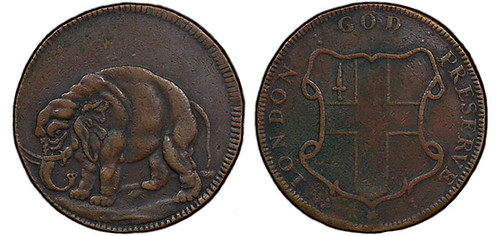
One of the examples I reviewed in-hand was a counterfeit "Hodder 2-B" elephant token "discovered" by my friend, fellow EAC'er and early copper specialist Kevin Vinton. Kevin told me there were several others like it with many in TPG genuine holders, sold through different auction venues, but he asked that I hold off on any further discussion while he continued his research.
After a couple of months passed I became curious and Kevin and I spoke and decided to post the topic in our counterfeit-focused Facebook group ("Dark Side") and start the discussion. Kevin included images of several like examples and we developed comparison images to genuine ones with the differences or "tells" to aid in the attribution of others "out there"
Jack's research on a piece in a recent national auction led back to earlier work by Eric P. Newman. -Editor
I posted this example and comparison images as a continuing discussion in my group and another friend stated it reminded him of an article in The Numismatist written by Eric P. Newman back in the 1960s. I immediately went to the website of the portal in his name (Newman Numismatic Portal) and started my search. The results were quick and the article was available there, entitled "AN ELEPHANT TOKEN NEVER FORGETS – FORGERY";
To read the complete article, see:
An Update on the (Counterfeit) Elephant in the Room
(https://coinweek.com/recent-articles-video/an-update-on-the-counterfeit-elephant-in-the-room/)
The large coin pictured in this article in Italian reminds me of the Buffalo Nickel. Found via The Explorator newsletter. To subscribe to Explorator, send a blank email message to: explorator+subscribe@groups.io. -Editor
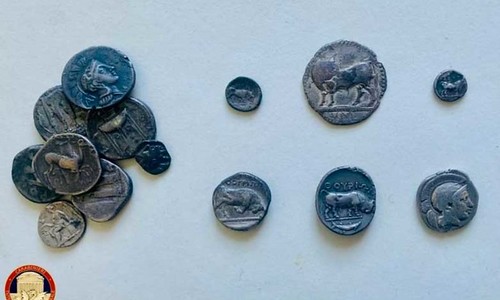
To read the complete article, see:
Tornano al museo archeologico di Sibari 665 monete del V-III secolo a.C.
(https://www.agi.it/cultura/news/2021-04-04/archeologia-tornano-sibari-monete-quinto-secolo-avanti-cristo-12036739/)
Jim Contursi passed along this article from the South China Morning Post on the obsolescence of coins and currency. Thanks. -Editor
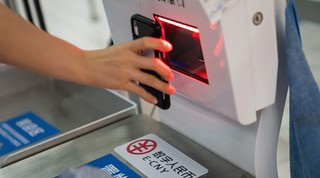 The ease with which I was able to accomplish a day's business and shopping without any banknotes or jangling change shows how our basic exchange economy is changing. In the last few years, this occurred in China through WeChat and Alipay, but elsewhere the pandemic has dramatically shortened the life of analogue cash by encouraging the use of non-cash payments. Much of Europe and Britain has leapfrogged Hong Kong by removing the need to use cash at all, even in the smallest outlet.
The ease with which I was able to accomplish a day's business and shopping without any banknotes or jangling change shows how our basic exchange economy is changing. In the last few years, this occurred in China through WeChat and Alipay, but elsewhere the pandemic has dramatically shortened the life of analogue cash by encouraging the use of non-cash payments. Much of Europe and Britain has leapfrogged Hong Kong by removing the need to use cash at all, even in the smallest outlet.
Many of the world's central banks, who authorise the issuance of cash as notes and coins, are actively looking at digitising national currencies, with the People's Bank of China leading the charge. It does not really matter who is first, apart from bragging rights, but it is leading a process whereby banknotes and worn-out pockets will disappear.
Alongside digitising their currency, some central banks are investigating a form of individual bank account provided at birth to handle government transactions, such as pensions and welfare payments throughout an individual's life.
To read the complete article, see:
How China-led digital payment revolution is making bills, coins and some currencies obsolete
(https://www.scmp.com/comment/opinion/article/3128615/how-china-led-digital-payment-revolution-making-bills-coins-and)


